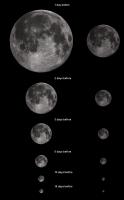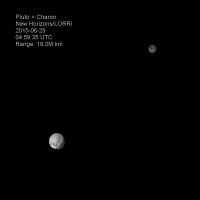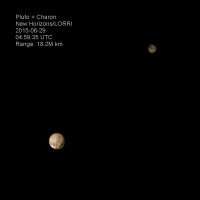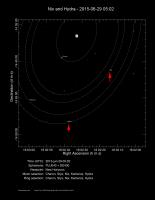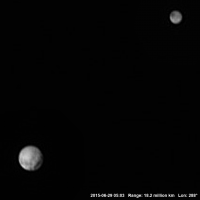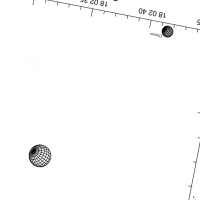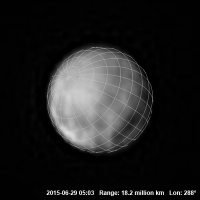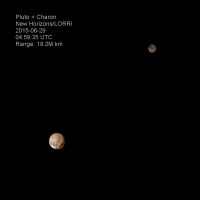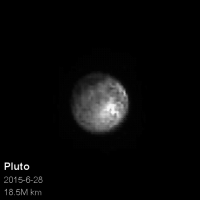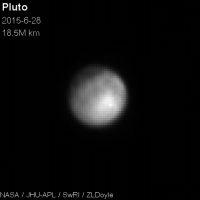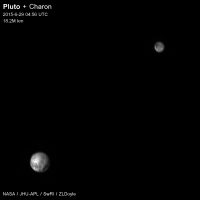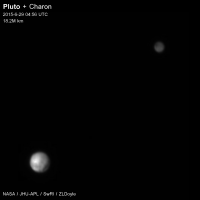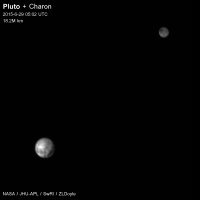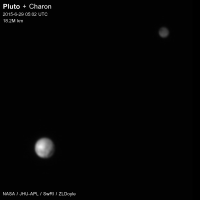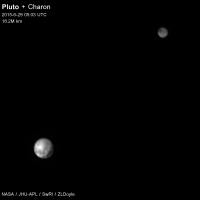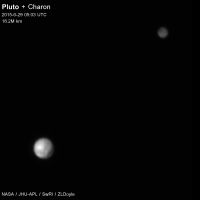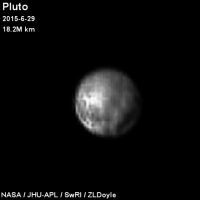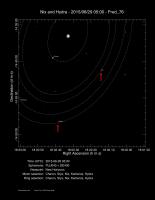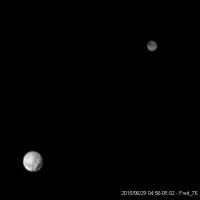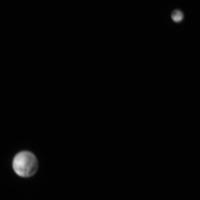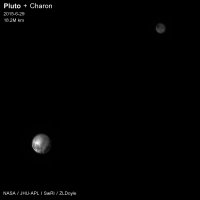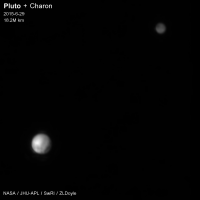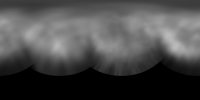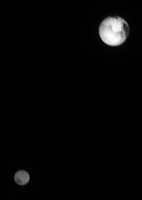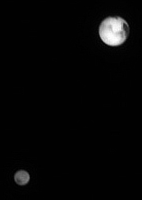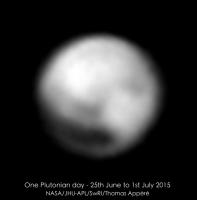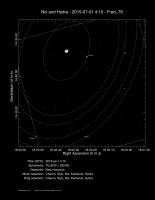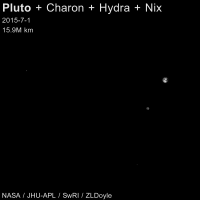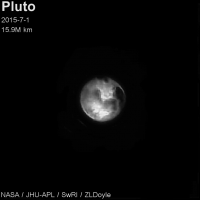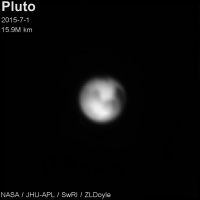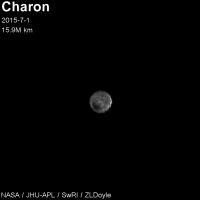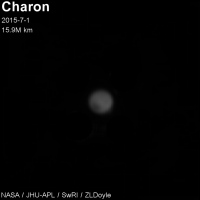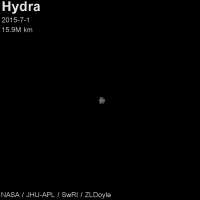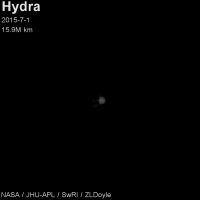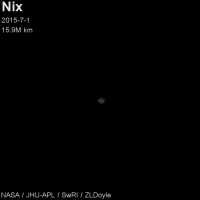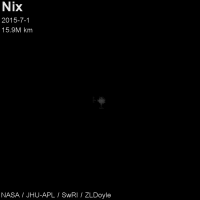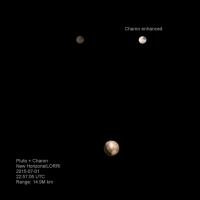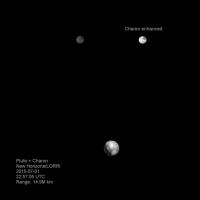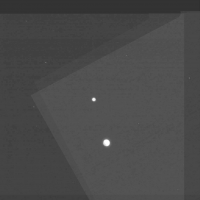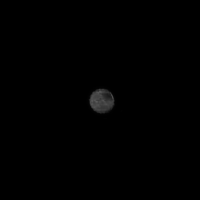Printable Version of Topic
Click here to view this topic in its original format
Unmanned Spaceflight.com _ New Horizons _ New Horizons Pluto System Final Approach
Posted by: nprev Jun 28 2015, 08:08 AM
More than nine years in flight, many more years before that in the making--this is the time. Please post all comments related to New Horizon's passage through the Pluto system here.
What to expect
Reminder that despite the rather brief duration of the actual encounter, it will be literally months before all acquired data is returned so this thread will be active for an equivalent time. Intrepid TPS space journalist and UMSF admin Emily Lakdawalla has written an excellent http://www.planetary.org/blogs/emily-lakdawalla/2015/03101637-pluto-image-expectations.html to planned imagery activities. EDIT: Updated version of http://www.planetary.org/blogs/emily-lakdawalla/2015/06240556-what-to-expect-new-horizons-pluto.html Emily has also produced a http://www.planetary.org/multimedia/space-images/charts/simulation-of-nh-lorri-data-set.html of the kinds of images that are anticipated.
FAQs
Most Forum members are advanced spaceflight enthusiasts; many are in fact professionals in space-related disciplines. Accordingly, there are no plans to post answers to questions that can be easily answered via a Google search, and we ask that everyone please attempt to do so before posting a question.
EDIT (4 Jul 15): Admin Astro0 has produced an extensive http://www.unmannedspaceflight.com/index.php?showtopic=8048&hl=.
EDIT: Review rule 1.9 and keep it firmly in mind before posting. Posts violating that rule will be deleted without notice.
____
With all that said, the most important thing by far is to witness the marvel of discovery, of exploration, of New Horizons on worlds never before seen. This is the best seat in the house for doing so, right in the comfort of our own homes. As with previous major events in planetary exploration over the past decade it is likely that not only professionals but also the press may be watching the Forum during the coming days due to its hard-earned reputation as a place for noise-free commentary and stunning contributions by amateur image processors, so please bear this in mind...
...and I can't stop smiling with anticipation and excitement. ![]() What marvelous things we will soon see. Enjoy the ride!!!
What marvelous things we will soon see. Enjoy the ride!!!
Posted by: um3k Jun 28 2015, 12:48 PM
I was born the same year Voyager visited Neptune, so this is the first of this sort of brand-new-world flyby* in my lifetime. It's super exciting!
*Excluding comets and asteroids, but I've arbitrary limited the meaning of "world" to bodies that won't let you accidentally tumble off into space.
Posted by: brellis Jun 28 2015, 05:35 PM
I remain curious about what can be learned from SOFIA observations of Pluto's June 29th occultation of a 12th mag star, and if it will have any bearing on the final opportunities for course correction.
Googling "New Horizons Last chance course correction" - from this http://www.americaspace.com/?p=83205:
Posted by: Superstring Jun 28 2015, 06:16 PM
*Excluding comets and asteroids, but I've arbitrary limited the meaning of "world" to bodies that won't let you accidentally tumble off into space.
Same. I count Ceres as a new world, but this is the first exploration of a *system* of worlds since 1989. It's also the first exploration of a world most of us have known about since childhood, which makes it extra special to me.
Posted by: Habukaz Jun 28 2015, 07:01 PM
First new world to be explored for the first time since Neptune with an atmosphere to speak of, I suppose we can say that much.
(though Titan almost ruins this one, too)
Posted by: David S. Jun 28 2015, 07:17 PM
I always think twice before saying anything not to add noise to this wonderful place, but I can't resist this time since this encounter will finally put an end to a 26 years long wait for me. I was 14 in 1989 when, right after the Neptune flyby, I started dreaming of seeing "the last one" up close in my lifetime.
There were times when I doubted it would happen but thanks to Alan and the amazing team behind this endeavour, that long wait will soon end in the most delightful way ! So, thanks a milion times to all the people involved for making this fourteen/forty years old happy ![]()
Going back to lurk mode now, eyes wide open !
Posted by: Tom Tamlyn Jun 28 2015, 08:45 PM
Nature has posted an http://www.nature.com/news/pluto-bound-probe-faces-its-toughest-task-finding-pluto-1.17811about the difficulties faced by New Horizons' two navigation teams.
Posted by: nprev Jun 28 2015, 09:32 PM
MOD NOTE: My fault for not making this clear in the kickoff post, but please review rule 1.9. Pluto's classification as an object will not be discussed here, period.
Fully understand the emotional connotations of this ongoing debate, but it is for precisely that reason that the topic is banned. One post removed for that reason. Please don't try to dance around it. Thanks.
Posted by: jgoldader Jun 28 2015, 10:45 PM
Maybe a little fun; is there a poll facility on the site? We could puree our collective brains into a jar and come up with the official unofficial UMSF list of predictions. For example,
New Horizons will see: (choose one)
No visual evidence of an atmosphere on Pluto
Limb haze on Pluto
Clouds on Pluto
New Horizons will see: (choose one)
No visual evidence of an atmosphere on Charon
Limb haze on Charon
Clouds on Charon
Number of new moonlets that will be discovered: 0, 1, 2, etc.
New Horizons will see:(choose one)
No evidence of recent geologic activity of resurfacing events on Pluto
Evidence of recent resurfacing but no ongoing activity on Pluto
Ongoing activity (geysers/etc caught in the act) on Pluto
New Horizons will see:(choose one)
No evidence of recent geologic activity of resurfacing events on Charon
Evidence of recent resurfacing but no ongoing activity on Charon
Ongoing activity (geysers/etc caught in the act) on Charon
Hydra and Nix will be: (choose one)
Roughly spherical
Irregular in shape
Artificial, the Mi-Go shipyards of Yuggoth (sorry, big Lovecraft fan)
Etc.
Posted by: JRehling Jun 28 2015, 11:08 PM
A bit of saccharine sentimentality, echoing an earlier post:
We will almost certainly never again in our lives see a world this big up-close for the first time, and perhaps no people will for many generations to come.
The biggest world closer than Neptune which we haven't seen up-close is Pallas, a quarter Pluto's size.
For fans of first looks at a world, this is the Omega. We'll probably get first looks at many small bodies: Comets, asteroids, and hopefully TNOs in the path of New Horizons, but to the extent that geological complexity requires some sort of minimum size, this is the last gasp.
The next time we get new science of such an interesting planetary body of this size, it will be something extrasolar, just a pixel across, giving up a few secrets to light curves, photometry, and spectroscopy.
Savor this. It's the last time.
Posted by: Mongo Jun 28 2015, 11:37 PM
The next time we get new science of such an interesting planetary body of this size, it will be something extrasolar, just a pixel across, giving up a few secrets to light curves, photometry, and spectroscopy.
There's always Eris, although I doubt I will still be around when it is finally visited.
Posted by: Superstring Jun 29 2015, 12:25 AM
Perhaps I'm being too optimistic, but I like to think we'll visit another big KBO in the next 50 years -- especially if Pluto proves to be really interesting. Probably not Eris, though, since it's so far away right now. I predict Haumea will be next, and hopefully some of us will be around to see it.
Either way, this flyby is historic and I'm thrilled to be around to take it in.
Posted by: Explorer1 Jun 29 2015, 12:31 AM
Sedna too, assuming a propulsion breakthrough in a couple of decades.
Also the unmapped hemispheres of Triton and the Uranian moons (though they're not quite in the same category of 'first time', I'll admit!)
Posted by: nprev Jun 29 2015, 05:23 AM
Copied a portion of Habukaz' calculated LORRI resolution & major object image widths for the next two weeks as a quick reference. Original post http://www.unmannedspaceflight.com/index.php?s=&showtopic=7970&view=findpost&p=219072:
29.06: 86.5 km/px - Pluto 28 pixels across, Charon 14 pixels
01.07: 74.7 km/px - Pluto 32 pixels across, Charon 16 pixels
03.07: 62.6 km/px - Pluto 38 pixels across, Charon 19 pixels
05.07: 50.9 km/px - Pluto 47 pixels across, Charon 24 pixels
07.07: 39.0 km/px - Pluto 62 pixels across, Charon 31 pixels
09.07: 27.1 km/px - Pluto 89 pixels across, Charon 45 pixels
11.07: 15.2 km/px - Pluto 158 pixels across, Charon 79 pixels
12.07: 12.7 km/px - Pluto 189 pixels across, Charon 96 pixels
Posted by: fred_76 Jun 29 2015, 05:53 AM
It is much easier to use these formulae to determine the size in pixels of the objects :
Pluto : 392/N px
Charon : 205/N px
Styx : ~3.5/N px
Nix : ~7/N px
Kerberos : ~5/N px
Hydra : ~8/N px
resolution = 5.9*N km/px
where N is the number of days (decimal number) before NH goes through the planetary system.
[i]For example, right now the number of days remaining is 15 days 5 hours, this gives 15.2 days.
The diameters are :
Pluto : 26 px
Charon : 14 px
Styx : < 1 px
Nix : < 1 px
Kerberos : < 1 px
Hydra : < 1 px
resolution = 90 km/px
A view of sizes, with the Moon as a model, full size :
Posted by: Habukaz Jun 29 2015, 12:34 PM
The SOFIA telescope is http://sen.com/news/sofia-to-work-with-new-horizons-during-upcoming-pluto-encounter Pluto occultating a star today; does anyone know if results of this will be available before the Pluto encounter? It would be interesting to know if Pluto's atmosphere is http://news.sciencemag.org/2011/04/plutos-expanding-atmosphere-confounds-researchers, remains stable or has started shrinking.
Another option would be to have a separate thread where members are invited to post their predictions for the Pluto system. I think it could be fun.
Posted by: Herobrine Jun 29 2015, 01:22 PM
@fred_76 At what point do those formulae cease being reasonable approximations? You have an asymptote to infinity on the day of the flyby.
Posted by: machi Jun 29 2015, 04:10 PM
Pluto+Charon today, magnified 2.5×.
EDIT: Added colorized version.
Posted by: fred_76 Jun 29 2015, 04:17 PM
In fact there are two things :
1) the approximation of the inverse tangente atan x ~ x because the diameter of the planet by far smaller than its distance from NH,
2) the asymptote you talk about
In practice, those formulae are quite valid until a pair of hours before "contact" as NH travels at 46500 km/h which is >> planets dia.
Posted by: Habukaz Jun 29 2015, 04:40 PM
Trying to compare one of the raw images from today (rotated only first from left, rotated and interpolated scaling second from left) with two deconvoluted releases from 8 June and 15 June (respectively):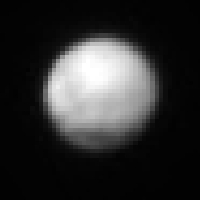
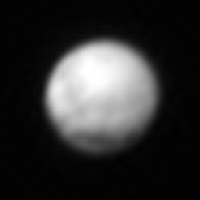
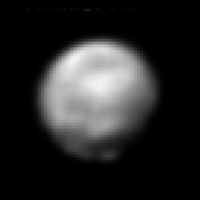
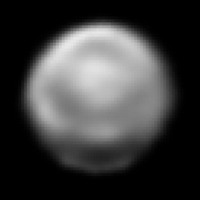
Posted by: fred_76 Jun 29 2015, 05:06 PM
Nix and Hydra viewed the 29th june's bin x 1 images. Kerberos still not visible.
Fred
Posted by: JRehling Jun 29 2015, 05:42 PM
Thanks, fred_76. This is a good way to convey the progression.
It's particularly poignant to see that 3-days-out image, because that's the best view we'll get of the anti-encounter hemisphere (AEH).
However, I'll point out that the Moon is about 1.5x the size of Pluto, so while Pluto will appear that *size*, we'll see Pluto at 1.5x the resolution that those Moon photos show. Consequently, we'll see the AEHs of Pluto and Charon at the same resolution as your left 2-days-out image of the Moon.
It's quite evident there that Tycho is a crater and one could surmise that Copernicus is. Otherwise, one could interpret the features in comparison to the better imagery of the other hemisphere, but on its own, it's still quite murky. The spectral imaging will add a lot, so that units on the AEH can be identified as likely similar to corresponding features on the encounter hemisphere.
The Charon-shine imagery may fill that in wonderfully, though, and even more important, give us a look at the winter pole that won't otherwise be seen at all.
The data set will basically be a tale of three Plutos: The encounter hemisphere, the anti-encounter daylight "hemi"sphere, and the winter pole. Similar for Charon, but we will only see its winter pole in Plutoshine from 3 days out, so we'll only get albedo/spectral information at very low resolution. On the other hand, Plutoshine is 4x brighter than Charonshine.
As a reminder of "shine" imagery, here's Iapetus in Saturnshine.
http://www.nasa.gov/mission_pages/cassini/multimedia/pia06168.html
Saturn is, of course, a hell of a lot bigger and brighter than Pluto or Charon, but it's also 200 times farther from Iapetus than Charon is from Pluto, so Charon occupies ~2x the area in Pluto's sky that Saturn occupies in Iapetus'. So Charonshine on Pluto is only a few times dimmer than Saturnshine on Iapetus.
Posted by: Mercure Jun 29 2015, 07:10 PM
So you won't remember how we saw Neptune on rasterized photos in the newspaper. Earth has changed a lot since those summer days of 1989, amazingly by now letting all of us have a front-row seat to, and be part of, space exploration. Thanks UMSF!
Posted by: fred_76 Jun 29 2015, 07:17 PM
@JRehling : I Know the moon is bigger than Pluto, therefore I redimensionned it's image so that it has the same size as Pluto, when views from the same distance.
Now, for sure, as Pluto is certainly not made from the same materials as Moon, it's aspect will be different.
Posted by: JRehling Jun 29 2015, 07:53 PM
Ah, sorry, Fred - I misread! My fault. And I'm doubly sorry, because that means the resolution will be 2/3 of what I'd thought.
The Moon seems, to me, to be unusually hard to interpret in its full phase. A lot of worlds, like Io, seem to look pretty good when full, but the Moon becomes a smear of maria, highlands, and rays. I hope Pluto is easier to make sense of in those distant, full images.
Posted by: Phil Stooke Jun 29 2015, 09:13 PM
Io may look pretty good when full... but it sure wasn't easy to interpret!
I think the difficulty in interpreting the Moon at small phase angles (full or nearly so) is repeated for all worlds, notably in recent times Ceres and now Pluto. When Ceres looked twice as detailed as Pluto does today, we had interpretations of giant rifts and canyons on this very forum. Only resolution saves us.
Phil
Posted by: Bjorn Jonsson Jun 29 2015, 09:39 PM
Here are the 2015-06-29 05:03 images. This is a stack of three images enlarged by a factor of 4. Two images were also obtained 6 minutes earlier that I could have added to the stack but the resolution is now probably high enough for Charon's changing position relative to Pluto to possibly have become a minor problem without correcting for it (but I notice that machi used them successfully). This image is also a 'milestone' of sorts because the size of Pluto (and the distance in pixels between Pluto and Charon) is now so big that from now on I will probably post images enlarged by a factor of 3 (or smaller) instead of 4.
And this is Pluto with a lat/lon grid:
This reveals that the pole may be close to the center of terrain that is slightly darker than the terrain farther from the pole. This is a somewhat tentative result though.
Charon's shape looks slightly irregular here (and also in machi's version), probably for the same reasons that Pluto looked slightly irregular at lower resolution (Pluto now appears perfectly spherical).
Posted by: machi Jun 29 2015, 09:56 PM
Here is slightly improved version. It's now made from 5 stacked images (previous was made from 4) and it's corrected for Charon's motion so Charon is now sharper.
BTW, darker area around Pluto's pole is almost certainly real feature because it's visible also in previous set from 28. June.
Posted by: jgoldader Jun 29 2015, 10:41 PM
These last few images remind me of Titan, sans atmosphere.
Posted by: Daniele_bianchino_Italy Jun 30 2015, 12:11 AM
Probably-stupid quedtion, There are possibilty that the Black Long feature are a metane or azote liquid lake?
Posted by: Explorer1 Jun 30 2015, 12:28 AM
Still too early to tell (17 million km to go!). If these images were coming out in a newspaper, I would not be taking a magnifying glass to them and exclaiming that Pluto is made of tiny coloured dots!
Two weeks left....
Posted by: jgoldader Jun 30 2015, 12:39 AM
Too cold, I think. Wolfram says methane's freezing point is around 90K and Pluto's colder than that. At least, it is today. But the bright and dark regions on the latest Pluto images reminded me of the bright highland and dark lowland regions (probably wrong nomenclature) on Titan. If we see something like that on Pluto, that would be very interesting indeed.
Posted by: nprev Jun 30 2015, 12:41 AM
Daniele, I don't think that it's possible for those to be methane lakes since Pluto's atmospheric pressure is far, far lower than even that of Mars; around three micro(not milli-)bars per this http://nssdc.gsfc.nasa.gov/planetary/factsheet/plutofact.html.
Posted by: Decepticon Jun 30 2015, 02:59 AM
I remember a day when triton was theorized to have lakes of methane.
Ciao!
Posted by: eliBonora Jun 30 2015, 03:21 AM
One stack of yesterday images (full 400%)
I cannot wait to focus on these features!
https://flic.kr/p/vjQcu3
Posted by: Gladstoner Jun 30 2015, 03:22 AM
The dark features may be more akin to those visible on Triton:
http://www.jpl.nasa.gov/spaceimages/details.php?id=PIA00329
Posted by: ZLD Jun 30 2015, 03:39 AM
Well, I was hopeful that all of the June 29 images could be stacked but I think there is actually enough movement that it degraded the quality too much for my liking.
Single frame on left, blink animation on right
June 28, 2015 - 2 images
Charon is absent in one of the images and so I simply excluded it.
June 29, 2015 - 04:56 UTC - 2 images
June 29, 2015 - 05:02 UTC - 2 images
June 29, 2015 - 05:03 UTC - 1 image
Keep in mind these are all limited data stacks so noise is likely to be apparent and different features are also likely to pop in and out of visibility.
Posted by: alk3997 Jun 30 2015, 03:52 AM
I thought I would see if I could tease some information out of the dark areas using a single image of Pluto/Charon. The original is the 6/29/15 at 05:03:10 UTC 1:1 bin image released today.
No stacking on this one. The only processing was a 4x enlargement followed by contrast/brightness/midtone enhancements.
If anyone would like to speculate about clouds the wispy area near Pluto's dark band certainly could be a starting point or it could be ice. Charon's anti-dark pole almost looks like it has some relief showing.
Anyway, just an attempt to find more information from the data (that will hopefully be obsolete within a week).
When we get images this quickly from New Horizons, it very much reminds me of watching Dr. Albert Hibbs and his guests at JPL explain Voyager images as they appeared on the monitors in real time during the Saturn/Uranus/Neptune encounters.
Andy
Posted by: Explorer1 Jun 30 2015, 04:30 AM
Andy
Will there be anything like that during the NASA TV coverage during the week of the flyby (i.e. seeing mission control)? I've read Emily's blog post but it seems like it will be a combination of press conferences and hammering refresh on the raw images page, not that that's a bad thing....
(Speaking of which, some dedicated Hydra targeting has started: http://pluto.jhuapl.edu/soc/Pluto-Encounter/index.php )
Posted by: nprev Jun 30 2015, 04:45 AM
Refer to the first post of this thread, and esp. to http://www.planetary.org/blogs/emily-lakdawalla/2015/03101637-pluto-image-expectations.html about planned activities. The data rate from Pluto's distance is nowhere near as high as it is during a Jupiter encounter (1kb/sec vs. something like 38 kb/sec), so we're likely gonna see just a few images with a good deal of time between them on encounter day. Per Emily's article again, only 1% of the acquired science data will be returned then.
Posted by: Explorer1 Jun 30 2015, 04:54 AM
Yep, I know how slow it will go considering how thin the data-pipe is over these distances. Just wondering about the coverage itself, beyond the critical 'beep' on the 14, all the live reactions from MC (which I'm such a sucker for!)
Also: SOFIA's observations got some good data: http://www.sofia.usra.edu/News/news_2015/06_29_15/index.html
Posted by: ZLD Jun 30 2015, 05:05 AM
Best I can do with the June 29 data. I think temporal blurring is subtle but likely problematic at the same time, even at this distance.
Posted by: fred_76 Jun 30 2015, 07:26 AM
Nix and Hydra the 29/06/2015 in the bin x1 images :
Close up on Pluto and Charon :
It seems there is a huge impact crater on Pluto...
Fred
Posted by: Explorer1 Jun 30 2015, 07:57 AM
We can't be seeing a crater shadow yet; NH is still at a tiny solar incidence angle until nearly closest approach; it's 'only' a dark patch (see the previous thread, with Bjorn's illustration).
Posted by: Habukaz Jun 30 2015, 08:55 AM
http://www.jpl.nasa.gov/spaceimages/details.php?id=PIA00329
In those images, the dark band near Triton's equator looks a lot like the dark bands near Pluto's equator; though it appears to be somewhat brighter on Triton.
In rotation videos, the shape looks wrong; too oblong.
It could though be possible to see different surface composition due to altitude - i.e. like mountains on Earth may have a white snow cover.
Posted by: fred_76 Jun 30 2015, 09:49 AM
However, the light coming from the Sun (the area facing the Sun is shown with the yellow dot) is quite correct to explain a potential crater rim illumination on the southern hemisphere of Pluto :
Posted by: 4throck Jun 30 2015, 09:55 AM
Here's my take on the 6/29 images.
5 image stack with unsharp mask, minimal level manipulation, to preserve the overall albedo variations.
I think that the pole shows up nicely this way, and the rest of the details are quite convincing.
Not that different from the other versions posted here, I guess that's a good thing :-)
Posted by: pitcapuozzo Jun 30 2015, 09:58 AM
Here are the phase diagrams of methane and nitrogen. As you can see, both are stable only as solids in Pluto's conditions (T = 35-55 K [-238 to -218°C], 10-20 microbar [0,00001-0,00002 bars])
Posted by: JRehling Jun 30 2015, 05:21 PM
I don't think *anything* endures as a liquid at pressures as low as Pluto's, at least nothing that's likely to exist in reasonable quantity at Pluto.
Interestingly, hydrogen and neon are liquid at Pluto's temperatures and 1 ATM. Maybe there could be underground liquifers of those, but they'd probably be in tiny abundance unless something has broken down a quantity of H2O. I doubt if we're going to see any signs of present liquid anywhere on Pluto, but some past impact/geological events may have left signs of melting behind. As I noted earlier, Charon may be even more likely to show this.
Posted by: Habukaz Jun 30 2015, 05:33 PM
Excerpt from http://www.planetary.org/blogs/emily-lakdawalla/2011/3182.html:
Posted by: pitcapuozzo Jun 30 2015, 05:45 PM
That's how we think Charon could have a transient atmosphere (other than the N2 escaping away from Pluto that it briefly intercepts). Impacts so far away from the sun happen much more slowly than in the inner solar system (1-2 km/s maximum, as Stern stays), and it would be possible for some of them to lift volatiles in the air and make a transient atmosphere around Charon. Stern and Gladstone calculated that Charon is hit by a 1-km KBO approx. every 10^6 yrs, and that such a transient atmosphere would last 10^4 yrs (as an upper limit value).
A few months ago, Gladstone told me: "Apart from the tenuous atmosphere Charon will intercept from Pluto’s escaping N2, the chances of Charon having an atmosphere during the New Horizons flyby are pretty small (but we may be surprised!)"
Posted by: neo56 Jun 30 2015, 06:09 PM
Here is my take on LORRI pictures taken on 28 and 29 June.
https://flic.kr/p/v7Ug31
https://flic.kr/p/voWY7Q
I'm enjoying holidays to catch up my delay on New Horizons photo processing ![]() So far I processed pictures from 23 to 29 June.
So far I processed pictures from 23 to 29 June.
Posted by: Herobrine Jun 30 2015, 06:30 PM
Since all the cool kids are doing it, I took a crack at bringing out features from the 5 LORRI images from 29 June. I opted not to do any deconvolution, to ensure I wasn't inventing features. I'm reasonably confident that any apparent features in these images are real and not artefacts. The result is more-or-less consistent with what has already been posted, but represents one more unique approach that indicates the same features.
Note: Probably best to ignore Charon here, as I aligned the images on Pluto (to 1/8th of a pixel). Charon moves by a noticeable amount between the first and fifth images due to its distance from the barycenter and I've done nothing to correct that movement.

Posted by: Phil Stooke Jun 30 2015, 07:53 PM
My stack of June 29th images. Charon's position was adjusted to correct for any movement. No deconvolution is done here.
Phil
Posted by: jgoldader Jun 30 2015, 08:39 PM
Downlink ongoing at present, 1kbps. Maybe images later tonight. ![]()
Posted by: ZLD Jun 30 2015, 09:06 PM
Looked into how much Pluto moved over the course of the course of 6 minutes and decided it wasn't probably enough to fudge too much detail so I had another go.
Much better this time around.
(click to animate)
I wouldn't probably trust the appearance of Charon. It does move a fair bit in 6 minutes and I did not correct for that in any way. Probably why It looks kinda oblong.
Posted by: pitcapuozzo Jun 30 2015, 09:45 PM
New Horizons has performed its last TCM (Trajectory Correction Maneuver) before Pluto Flyby.
Stats: third Pluto-approach TCM, sixth TCM since 2006
Date: 3:01 am UTC, June 30th / 11:01 pm EDT, June 29th / 5:01 am CEST, June 30th
Delta-V: 27 cm/s (0.97 km/h)
Delta-T: 23s
Spatial correction: 184 km
Time correction: 20 seconds late
First TCM telemetry: 9:10 am UTC, June 30th / 5:30 am EDT, June 30th / 11:30 am CEST, June 30th
http://pluto.jhuapl.edu/News-Center/News-Article.php?page=20150630
Posted by: Gerald Jun 30 2015, 10:26 PM
"OpNav Campaign 4, LORRI 1X1", update of animated gif until 2015-06-29, 27 frames:
Individual frames have been obtained by registering/stacking/cleaning/"dark frame subtraction" of image sets; the resulting frames have then been registered to (faint) background stars as a common reference for the animation.
Posted by: pioneer Jun 30 2015, 10:36 PM
Neat. I was wondering if anyone was going to create an approach animation with the latest LORRI optical navigation images.
Posted by: nprev Jul 1 2015, 12:44 AM
Here's the official release re today's http://pluto.jhuapl.edu/News-Center/News-Article.php?page=20150630.
So does this mean that rings and other potentially hazardous debris have been definitively ruled out? According to the 15 Jun http://pluto.jhuapl.edu/News-Center/News-Article.php?page=20150615 the final analysis was to be completed on 25 Jun, but there doesn't seem to be any announcement of that happening on the site.
Posted by: stevesliva Jul 1 2015, 04:31 AM
How wide do you want your error bars?
Posted by: ZLD Jul 1 2015, 05:42 AM
As I understand the situation with debris is that it is likely to be in the system but the 4x4 binning should have been able to detect anything that they could avoid but not necessarily much smaller particles. Still haven't seen anything suggesting clouds of debris but we can't easily see the rings of Jupiter on the sun facing side either. It'll probably be fine.
Posted by: Gerald Jul 1 2015, 09:04 AM
Debris should be correlated to the presence of additional satellites.
Since we can now distinguish Kerberos, and sometimes Styx in the lossy version of the 4x4 images, those potential smaller satellites should be detectable down to about 1/16 the brightness of Styx/Kerberos or even below by analysing the lossless images. Sensitivity close to Pluto/Charon is maybe not quite as good, due to scattered and reflected light in the LORRI optics, pixel bleeding, and some frame transfer smear.
Detection of small satellites is also dependent of their orbit. Satellites on circular orbits, coplanar to Charon's, are more likely to be detected than satellites with highly inclined, eccentric orbits. Satellites on resonant orbits are particularly likely to be detected, since simulations show where to look for.
Then two analysis results need to be distinguished: Evident or definitive detection of a satellite in the sense of a discovery, and evident non-detection of a new satellite or a ring in the sense of absence of hazards above a given probability.
The latest of these "Search for sources of hazardous material" series, available thus far, are of http://pluto.jhuapl.edu/soc/Pluto-Encounter/view_obs.php?image=data/pluto/level2/lor/jpeg/029762/lor_0297620568_0x633_sci_1.jpg&utc_time=2015-06-26%3Cbr%3E10:30:45%20UTC&description=Search+for+sources+of+hazardous+material.&target=PLUTO&range=21.5M%20km&exposure=9967%20msec.
Accurate analysis and preparation of an official statement takes time.
Posted by: pitcapuozzo Jul 1 2015, 09:52 AM
I was wondering, just how old could the surface of Pluto be? I mean, it is tidally locked with Charon, so the lack of tidal heating should make it a pretty inactive world, right? That would make me think its surface should be pretty old. But on the other side, with all that sublimation action going on between atmosphere and surface (I even read something about "sublimation winds") and material exchange between Pluto and its moons (I recently read a paper about that), Pluto would seem a pretty dynamic world. So, do we expect its surface to be young, old or whatever in between?
Posted by: craigmcg Jul 1 2015, 10:16 AM
One tidbit I liked from the AMA session yesterday was that at some point they might adjust the spacecraft clock in order to deal with uncertainties in Pluto's position. I assume that is partially because it's a low-risk, low-bandwidth change, and also because the biggest uncertainty is along the radial axis?
Posted by: Mercure Jul 1 2015, 10:33 AM
https://www.reddit.com/r/IAmA/comments/3bnjhe/hi_i_am_alan_stern_head_of_nasas_new_horizons/
(Link to the recent Reddit "Ask me anything"-session by the New Horizons team)
Posted by: pitcapuozzo Jul 1 2015, 12:24 PM
(I hope I understand the question correctly) they are doing so because after July 4th they can't perform any new maneuvre with the propulsion system, so if the find they're a bit late or a bit early compared to the planned trajectory, they are simply going to move the science sequence in time instead of moving the spacecraft in space.
Posted by: pitcapuozzo Jul 1 2015, 01:01 PM
So, we have methane! Not that we didn't already know that, but an important proof that the instruments are working as desidered. Also, an important test of Alice, the spectrograph which will observe the Pluto-Sun and Charon-Sun occultations.
http://www.nasa.gov/feature/new-horizons-update-methane-detected-new-images-of-pluto-and-charon-sunrisesunset/
Posted by: 4throck Jul 1 2015, 01:25 PM
Also nice approach animations on that link!
Posted by: Phil Stooke Jul 1 2015, 02:00 PM
This is a composite of all the different versions of the June 29th images posted here. We all have different processing methods, so this is averaging them, hopefully to reduce processing artifacts.
Phil
Posted by: dudley Jul 1 2015, 02:39 PM
The very large feature that resembles a crater appears to be at least 1/2 of Pluto's diameter. Wouldn't an impact of that size have destroyed the integrity of the planet and erased all traces of itself? Does this consideration rule out an impact crater as an explanation of this feature?
Posted by: alk3997 Jul 1 2015, 02:48 PM
Still too far away and too much image processing to say this is a crater. It could be albedo differences that your eye/brain forms into a crater.
As to your question, how does a methane crater form in these temperatures? I don't know how much strength is provided by methane at very very cold temperatures.
Posted by: Habukaz Jul 1 2015, 03:52 PM
Pluto during a rotation that is close to a full one from the deconvolved release:
Compare Pluto to http://photojournal.jpl.nasa.gov/catalog/PIA02212 in these images:


Compare the zig-zag dark border on Pluto to the dark border on Triton. Triton's dark border seems less sinuous, but given that both borders are pretty close to a pole in summer...maybe they are related. I thought Pluto looked ridiculously much like Triton when I first saw those frames in the animation (Triton's border looks more sinuous in some of http://photojournal.jpl.nasa.gov/catalog/PIA00329 images).
Posted by: Phil Stooke Jul 1 2015, 03:58 PM
That is a very useful comparison. Thanks for posting it.
Phil
Posted by: MahFL Jul 1 2015, 04:55 PM
July 1 pics down :
http://pluto.jhuapl.edu/soc/Pluto-Encounter/
Posted by: EDG Jul 1 2015, 04:57 PM
I was looking at the latest pic from NH at:
http://pluto.jhuapl.edu/soc/Pluto-Encounter/view_obs.php?image=data/pluto/level2/lor/jpeg/029803/lor_0298030209_0x630_sci_1.jpg&utc_time=2015-07-01%3Cbr%3E04:18:10%20UTC&description=OpNav+Campaign+4%2C+LORRI+1X1&target=HYDRA&range=15.9M%20km&exposure=150%20msec
and I spotted two little dots (at 10:00 and 7:00 positions relative to Charon) - are those two of the smaller moons? I did a bit of histogram stretching around the dots to enhance them a bit, but haven't done anything else to the image.
Posted by: Habukaz Jul 1 2015, 05:12 PM
Finally feels like we are in flyby mode. ![]() The latest pics are really awesome.
The latest pics are really awesome.
Deconvolved release from 25 June vs. raw image from today:
(the deconvolved frame is darker in the upper part and the black band there is thicker; the comparison was quickly and not carefully made (!))
Posted by: volcanopele Jul 1 2015, 05:46 PM
Hydra and Nix are visible in the full-frame mode images from July 1:
I've also summed the three "Hydra" images, enlarged by 200%, and rotated so that Pluto north is up:
Posted by: Nafnlaus Jul 1 2015, 06:36 PM
Wow, hardly even needs processing any more...
http://"
Even the raw images are getting impressive.
Posted by: neo56 Jul 1 2015, 07:36 PM
My take on pictures taken on 29 June at 23h07 UTC and today 1st July at 4h14 UTC:
https://flic.kr/p/vaCFaJ
https://flic.kr/p/vsjNLB
Posted by: JRehling Jul 1 2015, 08:06 PM
Pinning down the history of tidal heating/interaction for an unknown world is totally impossible. Variables describing how the internal structure reacts to tidal stresses are not only unknown for Pluto and Charon, we don't even know those things for Venus and Mars. What was the initial state of the system: Was Charon in a highly elliptical orbit that required tremendous energy to circularize, or was it pretty circular in the first place? We have no idea. (Well, we have some idea, but not very precisely.) So we have no idea how much energy was converted to heat, or at what rate it was converted to heat. Nor have we seen any close analogues to this system.
It's not yet understood exactly why Enceladus has thermal heating altering its surface into recent times and, say, Dione, does not, nor why the southern hemisphere of Enceladus monopolizes all the activity while the northern hemisphere is ancient. So when we don't understand worlds that we've imaged very well, forget about predicting the internal history of un-seen worlds with any accuracy.
Some things about Pluto's atmosphere are a bit clearer, but only a bit. Certainly seasonal changes have the ability to deposit/remove thin layers which are optically observable, and there's been data to that effect for many years now.
Posted by: FOV Jul 1 2015, 08:26 PM
Pluto and Charon:
Getting more difficult to process both Pluto and Charon together in one image. And yeah Pluto and Charon are getting big enough in the LORRI images to see features clearly, no processing required. On to spotting Nix, Hydra, Styx, Kerberos.
Posted by: Julius Jul 1 2015, 08:43 PM
The Pluto system is really coming into view now. It is still surprising even thou it was mentioned before, to see the sharp contrast between light and dark surfaces on Pluto.
Posted by: Mercure Jul 1 2015, 09:12 PM
Weirdly, the closest visual match to these last images of Pluto & Charon would actually be the Earth and the Moon, what with Plutos clear delineation in dark and bright areas and Charons more uniform greycard albedo surface (excepting the Pole).
Posted by: Alan Stern Jul 1 2015, 09:41 PM
Indeed. We've been occasionally discussing the same on the NH science team the past couple of weeks. That is an old analogy for this system and it applies in other ways (e.g., Earth--like Pluto--also has the volatiles, the color, and the atmosphere; Charon--like the Moon--has none of those).
Posted by: ZLD Jul 1 2015, 09:49 PM
Hey Alan, since you are on, do we have any other colors than orange through MVIC as of today? Or is that supposed to be a surprise?
Edit: And... he's off. Oh well.
Posted by: machi Jul 1 2015, 10:28 PM
Processed images from 29.6. and 1.7. Magnification 2.5×.
B&W and colorized version.
Posted by: Herobrine Jul 1 2015, 10:32 PM
Plot twist:

Posted by: JRehling Jul 1 2015, 10:38 PM
Are we seeing a specular glint between the center and the limb?
Maybe it's wishful thinking.
Posted by: Explorer1 Jul 1 2015, 10:46 PM
http://www.nasa.gov/press-release/nasa-s-new-horizons-spacecraft-stays-the-course-to-pluto
All clear confirmed! No debris, so no further TCM needed.
Posted by: machi Jul 1 2015, 10:56 PM
I have no idea. As it's based on the processing of 5 images, it can be easily remnant of some DCT compression artifact.
But Triton has few smooth frozen plains/lakes so we can expect many interesting things (it's already magnificent view!).
Posted by: Gladstoner Jul 1 2015, 11:05 PM
If there was a specular reflection, where would it be on the disk?
Posted by: pitcapuozzo Jul 1 2015, 11:40 PM
Damn, these evenly spaced equatorial dark patches are on the opposite hemisphere, the one that will set over the horizons at P-3 days.
http://www.nasa.gov/feature/new-horizons-color-images-reveal-two-distinct-faces-of-pluto-series-of-spots-that-fascinate
Posted by: Phil Stooke Jul 1 2015, 11:51 PM
True, but don't forget we will still be able to see half of it at P-1.5 days.
Phil
Posted by: Bjorn Jonsson Jul 1 2015, 11:51 PM
Specular reflections are very unlikely in my opinion, also they would be more likely to be visible at high phase angles.
Here is my version of the 2015-07-01 images, a stack of 5 images. For the first time I stacked Pluto and Charon separately using the 2015-07-01 04:17:10 image as reference. The image is enlarged by a factor of 3. The details in this version of these images are consistent with the images already posted here.
Now the resolution is improving rapidly, there is a big difference from the June 29 images. It is now pretty clear that the dark terrain isn't continuous around Pluto's equatorial region and there are now also clear hints of bright terrain south of the dark terrain. Since the dark terrain now covers several pixels in the original JPGs it is now possible to measure its brightness more accurately than earlier. The bright terrain is ~3 times brighter than the dark terrain. Pluto's 'dark' polar cap is very subtle in the original JPGs but it is defnitely visible there. Pluto is now starting to remind me more of Triton than it did 1-2 weeks ago.
Charon is looking steadily more interesting and is now as big in the images as Pluto was in mid-June. The large dark markings in the processed images are real and there are possible hints of an irregular light-dark boundary.
Posted by: pitcapuozzo Jul 1 2015, 11:54 PM
True. Plus, they all seem alike, so we really just need to see one to see them all. However it would be interesting to see the space in between, if it's something like a geological boundary (ridges etc) or not.
Posted by: Bjorn Jonsson Jul 2 2015, 12:34 AM
Here is a very early and very quick and dirty attempt to do a map of Charon. This is from the June 27 and 29 and the July 1 images. The map is extremely crude but at least this is a starting point. There are at least two features here that are definitely real: The dark north polar region and the dark area farther south near the right edge of the map. Longitude 0 is at the left edge of the map.
Posted by: Phil Stooke Jul 2 2015, 12:38 AM
One for the history books! (history of planetary cartography books anyway).
Phil
Posted by: mmatessa Jul 2 2015, 01:23 AM
I found instructions for making a foldable Pluto globe based on HST imagery at http://pluto.jhuapl.edu/common/content/activities/plutoglobe.pdf
Does anyone know if there's an automated way to make an icosahedron projection from the maps of Pluto (and Charon!) people are making here?
Posted by: ZLD Jul 2 2015, 05:15 AM
Alright have more to share here. Haven't yet done the July 1 images but I will before the night is out. I wanted to have a go at getting a hold on Nix before proceeding to have something for comparison.
Each body was processed separately to maximize output.
Here is a composite matching the raw June 29 series 4 frames.
Pluto
---------------
Edit: forgot a step here, corrected luminance slightly - more closely matches previous release from me
Charon
---------------
Nix
---------------
A quick note about Nix. It may be completely inaccurate. No idea until there is more to compare. I had to boost gamma quite a bit to pull out anything at all which could have introduced noise or other artifacts. I feel confident in my work here but grains of salt here as well. Time will tell.
Posted by: Julius Jul 2 2015, 09:00 AM
Just speculating. The dark equatorial regions and the bright polar cap would seem to indicate some process leading to preferential hydrocarbon 'sand' deposition in lower latitudes as for ice deposits at higher latitudes. Except for that bright region which seems to straddle the equator which would therefore seem to show it to be some land mass analogous to Xanadu on Titan. Would this be a sign of plate tectonics on Pluto in keeping with a hypothesized internal ocean ?
Posted by: Gerald Jul 2 2015, 09:27 AM
Close to the center, since New Horizons approaches roughly from the direction of the Sun, unless the presumed specular surface is significantly inclined.
Posted by: lollipop Jul 2 2015, 10:11 AM
"Roughly" is right,
NH is charging out radially at 13km/s, but isn't pointed at Pluto. It is going towards the point where Pluto will be in 12 days. Pluto meanwhile trundles in from the West at about 3km/s towards that point. I think (and I emphasise "think" that NH should be looking about 15 degrees to the West of its flight path to see Pluto. A specular reflection should be offset from the optical centre by about 7.5 degrees
Posted by: Herobrine Jul 2 2015, 10:36 AM
Here's my attempt at the 1 July images. I did do some deconvolution this time.
PNG
Charon clears up a bit. Pluto hardly needs anything at this point.
Posted by: tolis Jul 2 2015, 11:06 AM
What do you call the mouse shadow on the second moon?
http://dune.wikia.com/wiki/Muad'dib_(moon)
Posted by: Steve5304 Jul 2 2015, 11:12 AM
Hard to tell. There really should not be anything going on its too cold but there are theories about methane snowfalls & Liquid Oxygen/Neon.. Springs/Lakes
But I know one thing...
Looking at the images we are in for some surprises in the next week
Posted by: alk3997 Jul 2 2015, 01:03 PM
Your Charon processing seems to confirm what I thought I saw in an earlier image. In the upper left it appears that Charon may have some higher elevations. Albedo changes? Possibly but I think when combined with earlier observations may indicate a peak instead.
Nice job on Nix. Any attempt at Hydra?
Andy
Posted by: Bjorn Jonsson Jul 2 2015, 01:43 PM
The resolution is far too low for things like peaks to be visible on Charon, especially when keeping in mid the low phase angle. On the other hand it is obvious that Charon has significant albedo variations across its surface.
Posted by: ZLD Jul 2 2015, 01:48 PM
Hydra is pretty dim in the series 4 June 29 images so I left it out. I may go back and try it later. July 1 has a much better view of Hydra and I will include it with that set. My process got exponentially more time consuming when I changed to this latest method followed by doing each body separately.
As for Charon, all I keep seeing is this guy from Mario:

Posted by: neo56 Jul 2 2015, 02:26 PM
I made an animation of a full Plutonian day using LORRI pictures from 25th June to 1st July.
Posted by: fred_76 Jul 2 2015, 02:52 PM
Pluto, Charon, Nix and Hydra from the bin x1 images of the 1st July :
Sadly, Kerberos is just outside of the field of view...
Fred
Posted by: ZLD Jul 2 2015, 06:07 PM
Alright, July 1.
First image again is a composite back into the raw image alignment.
----------
Pluto
----------
(click to animate)
----------
Charon
----------
(click to animate)
----------
Hydra
----------
(click to animate)
----------
Nix
----------
Word of caution with the small moons again. They are incredibly dim and little detail can be brought out from the raw images. One image of Nix is even just a line. Interpret as you will.
Posted by: machi Jul 2 2015, 07:17 PM
Reprocessed images from the new sequence from 1.7.2015.
Magnified 2.5×.
Posted by: Ian R Jul 2 2015, 07:30 PM
Fantastic work, Dan: it almost looks for all the world like a mini-Ganymede's ended-up in orbit around Titan.
Posted by: tedstryk Jul 2 2015, 07:34 PM
Charon and Pluto on July 1 vs Triton from Voyager on August 19, 1989, six days out and at a similar scale. The clear filter is used. I've done nothing to Pluto and Charon except enlarged them 3x and moved Charon closer. I cleaned up the Triton image to get rid of noise and enlarged it 3x. It is amazing to see how much greater the contrast variations on Pluto (and even Charon) are.
Posted by: machi Jul 2 2015, 07:43 PM
It depends also on the contrast of camera and onboard processing. Voyager has old vidicons with 8 bits per pixel after all and no onboard processing.
EDIT: But I remember that Ganymede has pretty nice contrast on the old vidicon images so Pluto has definitely much higher contrast between different regions than Triton.
Thanks Ian!
Yeah, exactly my thoughts too. Ganymede and Titan!
Posted by: nprev Jul 2 2015, 08:15 PM
Absolutely tantalizing. I am astonished at the emerging complexity of Pluto's surface, and it seems likely that Charon's is no less so. Beautiful work, Daniel!!! ![]()
Posted by: Decepticon Jul 2 2015, 08:57 PM
Machi North is Up?
Posted by: volcanopele Jul 2 2015, 09:06 PM
Here's an animated gif running a little over one full Pluto day. Includes the latest dataset (2015-07-01 22:54:15 UTC)
Posted by: machi Jul 2 2015, 09:11 PM
Almost, here is Pluto with coordinate grid.
Posted by: tedstryk Jul 2 2015, 09:22 PM
The difference is real. I first noticed it when I was comparing Hubble ACS HRI images of Pluto and Triton. Triton isn't a very contrasty place. Pluto is perhaps the most contrasty place in the solar system. Of course this could all be about frost/lack thereof. And as we learned at Mars, albedo features might have a very strange relationship with geology and photography. This is getting interesting.
Posted by: machi Jul 2 2015, 10:16 PM
True, I have somewhere on my disk old images of Triton and Pluto from HST's FOC camera.
Images of both bodies shows prominent albedo features but Pluto was definitely more contrasty.
For comparison, albedo features on Ceres were well outside capabilities of the FOC camera.
Posted by: Gladstoner Jul 2 2015, 10:19 PM
For reference, primary causes of albedo variations of some objects in the Solar System:
Earth - Ocean, land, polar ice, clouds
Moon - Highlands and maria/lava
Mars - Exposed rock, dust, polar ice
Ganymede - Exposed ice and rocky regolith
Titan - Ice, dunes, lakes
Iapetus - Ice and Phoebean dust
Triton - Methane/nitrogen ice on water ice (?)
Pluto - ?
Charon - ?
I think I got them right....
Posted by: alk3997 Jul 2 2015, 11:32 PM
I didn't see today's release here, so I'm attaching the link:
http://pluto.jhuapl.edu/News-Center/News-Article.php?page=20150701-2
Color overlay and some really fantastic image processing. I have no idea what the Pluto "train track terrain" (right hand image) could possible be.
Andy
Posted by: Gerald Jul 3 2015, 01:23 AM
"Search for sources of hazardous material", 2015-07-01, blink gif, roughly aligned, candidates for Styx and Kerberos (the only subtle, but evident moving blips I could find, without looking up the predicted positions) marked:
The series are composed of 8 sets of image triples, this time:
http://imgur.com/XnUyzD1 http://imgur.com/rKTGqHn
Posted by: wildespace Jul 3 2015, 03:41 AM
Sorry if this has been posted before, but I just found Hydra in the latest LORRI images! ![]()
http://pluto.jhuapl.edu/soc/Pluto-Encounter/data/pluto/level2/lor/jpeg/029809/lor_0298097144_0x630_sci_1.jpg
It's about 10 o-clock from Charon in that image. Here's an enhanced version with Hydra pointed out:
Nix is also visible. I've verified both moons in Stellarium.
Posted by: ZLD Jul 3 2015, 04:16 AM
Second series from July 1. No smaller moons this time as they didn't align well.
---------------
Composite
---------------
---------------
Pluto
---------------
(click to animate)
---------------
Charon
---------------
A note about Charon this time. This is a 5 image stack however 2 of the images had to be rotated into alignment which can introduce some artifacts and blurring. The dark line along the top of Charon may be a remnant of this alignment not being perfect. Time will tell.
Next up, hopefully morphing these.
---------------
Edit
---------------
Deleted this edit. Features apparent in the previous July 1 are present here, although smudged. No way around that unfortunately. For those who read this, no tiger stripes, that was an artifact.
Posted by: neo56 Jul 3 2015, 06:54 AM
Here is my take for LORRI picture of 1st July at 22h54:
https://flic.kr/p/vvWaSg
Posted by: xflare Jul 3 2015, 08:18 AM
Andy
My imagination is saying they are a chain of giant nitrogen/methane geysers!!
Posted by: ElkGroveDan Jul 3 2015, 12:54 PM
Congratulations to you Alan and you entire team for reaching this important milestone.
Posted by: Nafnlaus Jul 3 2015, 12:57 PM
Always scale up before alignment.
Posted by: alk3997 Jul 3 2015, 01:47 PM
I don't know about geysers but the location of the dark band and the train tracks seem to be just off the equator. That would suggest that maybe Charon is "helping" with this structure.
Maybe the side with the railroad ties just hasn't been fully resurfaced yet, leaving the ties visible? That's certainly more imagination than fact, at this point.
Andy
Posted by: vikingmars Jul 3 2015, 02:21 PM
Thank you Machi and Neo56 for those nice views !
Although the geology at Pluto must be totally different from what we see on the terrestrial planets, your views remind me the old-fashioned 'romantic' views of Mars we had when I was a kid...
Posted by: MarsInMyLifetime Jul 3 2015, 02:37 PM
The "structure" does comprise some possible Morse code characters, depending how you parse the sequence:
_... = B
..._ = V (or the opening notes of Beethoven's fifth symphony)
... _ = ST (or TS walked the opposite direction)
Is there a message here?
More seriously, though, the pattern could indicate deposits sorted by mascons or by standing waves in a magnetosphere.
Posted by: ZLD Jul 3 2015, 02:37 PM
During the rotation of image 4 and image 5, to ensure the least amount of blurring from the process, I worked with the files at 16384x16384. Everything else is extremely sensitive to this alignment. Got out pen, paper and calculator, got as close as I could but the process still resulted in a small amount of blurring and it still may have been off by several ten thousandths of a degree which can matter in the final product.
Here's what everything looked like after alignment, downscaling and a giant gamma boost:
----------
Edit
----------
Apparently the error wasn't in the initial alignment, it was in my final stack of Charon. Normally I do a better error scan of my stacks but this slipped by this time.
Here is a better result of Charon, round again, thankfully.
Typically I process everything twice with two rather different methods, for a second reference. Did not do that this time.g
Posted by: alk3997 Jul 3 2015, 03:10 PM
For those outside of the U.S. who may not be aware of this, July 4th is Independence Day in the U.S. Since the 4th falls on a Saturday this year, the U.S. federal holiday is today, July 3rd.
So, I don't know if we are going to see any more SOC updates before Sunday.
Andy
Posted by: Steve5304 Jul 3 2015, 03:35 PM
Charon kinda looking like miranda at that angle although probably still artifacting
Posted by: ZLD Jul 3 2015, 03:39 PM
Probably some artifacting yes but hopefully just from noise presence. For the version I just posted, I ran through about 6 different processing methods, going all the back to the beginning for each and got nearly exact results each time, with varying degrees of clarity. Even the distorted version has many similar features, although distorted of course. I like to be thorough.
Posted by: Julius Jul 3 2015, 04:42 PM
I am still puzzled by the nature of the bright patch just over the equator. Could it represent different ice compostion from the polar region or could it be a cryovolcano?
Posted by: nprev Jul 3 2015, 05:36 PM
Nobody has the vaguest idea what any of these albedo variations are caused by yet, Julius. Hopefully we'll know quite soon. ![]()
Posted by: Steve5304 Jul 3 2015, 06:27 PM
Could be just higher/lower terrain like the moon exposing different type of.rock
Posted by: alk3997 Jul 3 2015, 07:15 PM
I just took a look at the color movie of a Charon orbit of Pluto. It seems the dark band on Pluto is ahead of Charon and the train track terrain is behind Charon. That's awfully coincidental if there isn't a cause and effect between Charon and Pluto.
http://www.nasa.gov/nh/pluto-charon-surfaces-in-color
It will be interesting if the railroad ties' height falls off in inverse square-law integers. In other words, I'm starting to wonder if the dark band and the train tracks aren't a result of tidal interactions with Charon.
Andy
Posted by: ZLD Jul 3 2015, 07:27 PM
I don't know of a mechanism but possibly the dark band has moved over time and left remnants. To me, mostly parallel lines, not in the direction of motion, says something magnetic or gravitational is going on.
Posted by: Explorer1 Jul 3 2015, 07:38 PM
The spacecraft has no magnetometer, so it could only detect a field indirectly (through the particle detectors, etc), correct?
Posted by: nprev Jul 3 2015, 08:10 PM
Emily has an updated version of her http://www.planetary.org/blogs/emily-lakdawalla/2015/06240556-what-to-expect-new-horizons-pluto.html to near-encounter activities.
Posted by: Aldebaran Jul 3 2015, 08:37 PM
It's an indication of how low the solar illumination is out there, but at 12 million kilometres separation, Pluto still only has an apparent magnitude of about 1.5, which is similar to that of Castor (Alpha Geminorum) as we see it from Earth, or the minimum magnitude of Saturn.
Posted by: Habukaz Jul 3 2015, 09:13 PM
A http://www.nasa.gov/nh/pluto-the-other-red-planet, including a deconvolved 1 July image and showing how the the LORRI images were coloured.
Posted by: Gladstoner Jul 3 2015, 09:15 PM
Goodness. I can't wait to see what those albedo terraces on Pluto are all about.
Posted by: Aldebaran Jul 3 2015, 10:13 PM
So the red colour is probably due to tholins, and by inference, probably represent the oldest (least disturbed) surfaces on Pluto. The lighter surfaces could be due to either fresher deposition of volatiles or ablation. It will be interesting to see how the red coloration is distributed. Will it be coincident with the lower albedo regions?
I'd say that the tholins are present as a relatively thin surface veneer.
This is starting to get really interesting.
Posted by: nprev Jul 3 2015, 10:42 PM
I'm going to speculate that we will see terrain qualitatively different than what's been seen before on other bodies. The fact that so much diversity is apparent from such a long range implies that Pluto & Charon's geological histories are significantly more complex than previously thought, and likely strongly influenced by each other.
"Interesting" may be an understatement. I'm beginning to think that Pluto may be less of a Triton clone than it is an airless Titan.
Posted by: Bjorn Jonsson Jul 4 2015, 12:00 AM
Here is my version of the 2015-07-01 22:54 images. This is a stack of three images. The images have been enlarged by a factor of 3. The processing is similar to earlier images except that I tried to avoid darkening the darkest terrain too much since that might lead to loss of details.
Pluto now looks increasingly mottled, especially in the bright terrain at lower right. Interestingly, this bright terrain looks considerably different from the bright terrain closer to the pole - it looks more mottled. I'm not sure the bright, vertical line at upper right is real since it's only obvious in one of the three source images.
Charon is now looking very interesting. Its dark terrain has a highly irregular boundary and I think this is mostly a real feature and not an artifact. It now seems clear to me that Charon is *very* different from Pluto (this has probably been obvious for some time now).
Posted by: Hungry4info Jul 4 2015, 03:18 AM
NASA has released another animation, this time showing a colour version of the raws. What's interesting to me is that the image at the end of this sequence is "new." (or at least I haven't seen it yet). Some of the equatorial dots mentioned before appear to merge in the new image? It makes me wonder how real this feature actually is.
http://www.nasa.gov/sites/default/files/thumbnails/image/nh-7-3-15_color_rotation_movie_nasa-jhuapl-swri.gif
Edit: Here's Pluto and Charon from the last frame.
Edit2: A lot less confident there's real surface feature change now, after figuring out where the sub-Charon longitude is in both images.
Posted by: Steve5304 Jul 4 2015, 04:00 AM
What's the spack above pluto\charon that seems to be in rotation but jumps back?
Posted by: alk3997 Jul 4 2015, 04:07 AM
A star. It moves because the center of the frame is being moved in each image since the Pluto/Charon barycenter is outside of Pluto. Normally Pluto would be seen moving around a point in space. In order to make it easier to see Pluto surface features, Pluto/Charon were moved so that Pluto always remains in the center of the image. This then results in stars moving from image to image in a circular manner.
It's easy to forget that Pluto/Charon are a double object and both orbit around a point in space.
MOD NOTE: See what I did there?
Posted by: Julius Jul 4 2015, 12:38 PM
From this release it is evident that there are dark streaks emanating from the dark equatorial spots and they seem to follow the same direction possibly along some persistent wind pattern or else stripes along geological fault lines!
Posted by: Nafnlaus Jul 4 2015, 04:50 PM
More and more detail (2 frames stacked, rotated, and unsharp-masked):
Trying to decide when I should start letting my mind see the sort of 3d contours that it wants to turn the albedo variations into. Let's see... 37 pixels wide... 1430km diameter, so ~39 kilometers per pixel near the center... so a sheer 2km-high mountain creating a perfect contrast between light and shadow would change the intensity 5% versus the average for the area... nope, probably still too soon for that. But maybe in a few days. ![]()
ED: Just uploaded a new version that has a roughly equivalent frame of the rotation from the last NASA release so one can see how the details are improving.
Posted by: volcanopele Jul 4 2015, 04:53 PM
The July 3 OPNAVs are on the New Horizons SOC page. Here's my 2x, summed, and sharpened version:
You can now make out some "islands" within Pluto's equatorial dark terrain. Hills above a dune sea? Recent impacts excavating buried bright material?
Here's also an updated rotation movie:
Posted by: machi Jul 4 2015, 05:00 PM
My version using nhttp://pluto.jhuapl.edu/Multimedia/Science-Photos/image.php?gallery_id=2&image_id=198 to colorize Pluto.
Posted by: Nafnlaus Jul 4 2015, 05:00 PM
You know, to those who said that Pluto is starting to remind them of an airless Titan...
https://upload.wikimedia.org/wikipedia/commons/4/45/Map_of_Titan_-_April_2011.jpg
More and more I'm inclined to agree (which IMHO is quite the good thing in my book as Titan is my favorite target for exploration! ![]() )
)
Posted by: Daniele_bianchino_Italy Jul 4 2015, 07:03 PM
Very good images Machi, hungry4info, Bjorn Jonsson, nafnalus, pele volcano.. :-)
Nafnalus Im I grate with you.. Titan is my favorite target for exploration! smile.gif )
Posted by: Steve5304 Jul 4 2015, 07:14 PM
When will we be able to resolve features..a week? ,not till after?
Posted by: MarsInMyLifetime Jul 4 2015, 07:24 PM
This animated gif marks the point where, for me, I've hit the Ahah! moment--now I can see where things are going to be headed (and many thanks to others for the references to Titan, which may indeed be a close analog after all). The spots appear to have organized streaks in almost a chevron shape (Coriolis effects?), with hints of opposing streaks in the vertically-flipped direction, implying perhaps seasonal (if atmospherically-challenged) implications. The equatorial deposition reminds me of the apparent deposition of ring material on Saturn's smaller moons, and I wonder whether Charon's color is due to that same material. What will we finally learn about these markings? I love how this story is unfolding!
Posted by: alk3997 Jul 4 2015, 07:30 PM
Hydra and Pluto/Charon images from July 3rd now available on NH SOC webpage:
http://pluto.jhuapl.edu/soc/Pluto-Encounter/view_obs.php?image=data/pluto/level2/lor/jpeg/029820/lor_0298204679_0x630_sci_1.jpg&utc_time=2015-07-03%3Cbr%3E04:46:00%20UTC&description=OpNav+Campaign+4%2C+LORRI+1X1&target=HYDRA&range=13.5M%20km&exposure=150%20msec
Two Pluto/Charon and three Hydra images. Below is Pluto/Charon from the last of the Hydra-targetted images. No enhancements, just cropping.
Andy
Posted by: FOV Jul 4 2015, 08:05 PM
No deconvolution:(
I have been wondering, even though it is a slight chance, if we are seeing any hazes or clouds at Pluto.
Posted by: Bjorn Jonsson Jul 4 2015, 08:39 PM
I was reading about Triton's photometric parameters a few days ago and came across something interesting: Triton's atmosphere contributes to Triton's limb darkening (at least at at low phase angles), i.e. Triton would be less limb darkened if it was a completely airless body. So the amount of limb darkening exhibited by Pluto might be affected by Pluto's atmosphere too - but I don't know the amount of limb darkening that Pluto should exhibit if it was airless. Also at high phase angles, Triton's brightness at the limb is affected by its atmosphere.
Posted by: nprev Jul 5 2015, 01:11 AM
Moved posts about Pluto landing methods to a http://www.unmannedspaceflight.com/index.php?showtopic=8049
Posted by: volcanopele Jul 5 2015, 02:42 AM
New Horizons went into safe mode today.
http://pluto.jhuapl.edu/News-Center/News-Article.php?page=20150704
Hopefully what ever caused it can be diagnosed and dealt with quickly, but expect a break in imaging for the next couple of days.
Posted by: nprev Jul 5 2015, 02:44 AM
Spacecraft anomaly earlier today, NH in safe mode. No science data acquisition for a bit till situation is resolved. Vehicle is in communication with Earth. NASA press release http://www.nasa.gov/nh/new-horizons-responds-spacecraft-anomaly.
Posted by: Arnold Evans Jul 5 2015, 03:19 AM
Immediate thoughts are that it didn't like something about the code that was uploaded yesterday. Curious: has anything like this ever happened before on this mission? I can't recall another anomaly.
Posted by: nprev Jul 5 2015, 03:27 AM
Difficult to speculate on a cause, and I'd advise against doing so here. Alan Stern is a UMSF member & participant so I'm sure we'll know more in due time (when he HAS time; I'm thinkin' like August! ![]() )
)
I don't know if there have been other anomalies, but wouldn't be surprised. Most missions have these from time to time. There is definitely no cause for alarm at this point.
Posted by: Explorer1 Jul 5 2015, 03:59 AM
Whew, and I was just reflecting on wiping the sweat from my forehead 10 years ago this night, too (Deep Impact anniversary)!
Posted by: s.pestana Jul 5 2015, 04:03 AM
Good luck to the NH team!
What science tasks were scheduled to be performed over the course of today since this happened? Nothing that can't be performed later?
Posted by: Phil Stooke Jul 5 2015, 04:15 AM
To help settle your minds a little bit, recall that (just a few examples) Mariner 7 had a serious anomaly just before arriving at Mars (when we really were NOT used to such things), Magellan had an almost catastrophic failure just after entering Venus orbit, and of course Spirit went bananas very early in the mission, and all went on to be very successful.
Phil
Posted by: Explorer1 Jul 5 2015, 04:39 AM
And of course, we can watch live communication with this wonderful little application (Thanks Doug!)
http://eyes.nasa.gov/dsn/dsn.html
Make sure to click 'more details'. Carrier wave still coming in from NH as of this post. We can breathe...
Posted by: djellison Jul 5 2015, 05:37 AM
currently TXing at 9 bps.... that's a safe mode alright!! Usually it's between 1k and 2kbps
The Voyagers typically do 160bps. Something like Dawn about 125kbps - MRO upto around 5Mbps.
Posted by: TheAnt Jul 5 2015, 05:38 AM
Also I had a look, at the time of my post they appear to be sending to NH if the graphic does not fool me.
With a round trip for of nearly 18 hour for a signal to any reply from the spacecraft I think it be a while before we get any further news of what happened, but I feel confident they manage. Even if it would take days there's still plenty of time to the close encounter at Pluto. We hold our thumbs for you though - all we can do! ![]()
Posted by: djellison Jul 5 2015, 05:43 AM
RTLT (Round Trip Light Time) for New Horizons is only 31748.800883 seconds right now - approx 8hrs 49 mins 8.8 seconds.
Not sure where you got 18 hours from.
Posted by: TheAnt Jul 5 2015, 05:47 AM
Sorry me bad, I had that 8 hours 49 minutes in my head and doubled the value. I should not post before I had my morning cup of coffee. =)
Correct value for round trip is as Djellison stated. =)
Posted by: nprev Jul 5 2015, 06:14 AM
Emily has a good http://www.planetary.org/blogs/emily-lakdawalla/2015/07042044-new-horizons-enters-safe-mode.html of the effects of this on science observations for the next couple of days. In a word, minimal.
Posted by: Steve5304 Jul 5 2015, 06:37 AM
Rumors that Contact with new horizons has been lost again or was never regained. Unconfirmed
Posted by: Explorer1 Jul 5 2015, 06:49 AM
Still showing data downlink on Eyes. Not longer just a carrier either; nearly 1 kb/sec!
Posted by: runningfool Jul 5 2015, 06:51 AM
Probably means they took it out of safe mode?
Posted by: alk3997 Jul 5 2015, 06:57 AM
It's better to go by the official statement from the New Horizons team than some unfounded rumor. Based on the information received, the spacecraft not only responded to the anomaly but was able to do a lot of autonomous switching, including switching to the backup system (that's not a single switch), verifying that an antenna was pointing towards Earth and configuring its telemetry system and transmitter for the lower bit rate.
This problem could range anywhere from a fault logic parameter that was too sensitive to a failure in one of the primary systems (which have backups) and anywhere in between. We, here, don't have the data to know what it is. We'll just have to have patience and wait to find out from the NH team. After all, there is nothing that any of us here can do about the anomaly but wait.
In the meantime, there are July 3rd images that could use some magic...
Andy
Posted by: nprev Jul 5 2015, 07:06 AM
Agreed. Eyes On The DSN has been clearly showing downlink for hours now so there is no need to spread obviously quite uninformed rumors from anonymous sources.
Posted by: alk3997 Jul 5 2015, 07:11 AM
I assume the NH team declared a "spacecraft emergency" and therefore now has priority at all of the DSN ground sites, when NH is in line of site.
Andy
Posted by: nprev Jul 5 2015, 07:12 AM
No idea, but I think that's standard procedure.
Posted by: Alan Stern Jul 5 2015, 07:17 AM
Such rumors are untrue. The bird is communicating nominally.
Posted by: xflare Jul 5 2015, 07:27 AM
Thanks for clearing that up
Posted by: Explorer1 Jul 5 2015, 07:27 AM
And that settles that! Going to sleep easy now, advise everyone else to do the same.
Posted by: climber Jul 5 2015, 07:30 AM
Thanks Alan for posting. We're checking in now in Europe and it's quite late in the US. Cheers to all the NH team.
Posted by: nprev Jul 5 2015, 07:42 AM
Thanks for checking in at a VERY busy time for you & the team to talk to us, Alan. ![]()
For those who may be unfamiliar, Dr. Stern is the New Horizons Primary Investigator (PI): the boss. If he says something that's the last word on it, period.
I'll also state that silly things like that rumor aren't suitable for this forum, especially if the PI feels it necessary to correct them personally during (of all things) a spacecraft anomaly recovery. Please keep this in mind at all times; they don't want or need that noise, they're more than busy enough already.
Posted by: qraal Jul 5 2015, 07:55 AM
The silly rumours can be quite disconcerting. Thanks to Alan for being interested enough to clear the air for all us spectators.
Adam
For those who may be unfamiliar, Dr. Stern is the New Horizons Primary Investigator (PI): the boss. If he says something that's the last word on it, period.
I'll also state that silly things like that rumor aren't suitable for this forum, especially if the PI feels it necessary to correct them personally during (of all things) a spacecraft anomaly recovery. Please keep this in mind at all times; they don't want or need that noise, they're more than busy enough already.
Posted by: jmjawors Jul 5 2015, 08:23 AM
I'm glad I came here to get things cleared up. Nasty rumors may not be worth the time and space here, but it's become national news.
[http://www.nbcnews.com/science/space/nasas-new-horizons-team-reviving-pluto-probe-after-anomaly-n386876]
Big thanks to Dr. Stern for clearing it up, and to all of you guys, too.
Posted by: TheAnt Jul 5 2015, 10:55 AM
Thank you Alan for taking time to inform us, and happy to hear that things are well.
Another look at the Eyes page show a steady 999.00 b/sec on the Canberra dish for the down signal but also transmitting from the dish if the graphic show correctly.
Posted by: Arnold Evans Jul 5 2015, 12:20 PM
I note on the DSN website that it currently shows antenna 43 is receiving NH data. What I am curious about is the fact that it shows two sets of "down signal" data that are nearly identical, but with slightly different power received numbers. Is that indicating that two receivers on the dish looking at NH? If so, is that unusual or fairly common for deep space missions?
Posted by: Harder Jul 5 2015, 12:44 PM
NH is maxing data transmission, using both amplifiers in parallell. See Emily’s blog entry “Talking to Pluto is hard!”.
Posted by: siravan Jul 5 2015, 12:46 PM
While waiting for NH to emerge from the safe-mode, I found it interesting that the downlink data rate is 999 bits/s. I guess it is generated at 1000 bits/s at NH, but is red-shifted twice in the full duplex mode down to 999 bits/s (NH velocity relative to Earth is 0.0005c). It gives a different perspective to feel the speed in this way.
Posted by: neo56 Jul 5 2015, 01:56 PM
Here is the LORRI picture taken on 3rd July (stack of five images, enlargement by a factor of 2.5 and wavelet sharpening).
https://flic.kr/p/vk3roV
Posted by: FOV Jul 5 2015, 03:39 PM
While waiting for good news re NH s/c recovery from anomaly, I stacked a couple more images from July 3. Heavy hand with wavelet processing this time. Not as aesthetically pleasing as my previous post (for me). It is difficult to know if one is wringing out more real detail, or just introducing artifacts. Fine line.
Posted by: neo56 Jul 5 2015, 03:45 PM
I updated my "Plutonian day" animation with the last LORRI pictures.
Posted by: ZLD Jul 5 2015, 04:49 PM
Heres a morph from the late June 29 series 4 data to the July 1 series 1 data. 29 hours, 1hr/s edit: 2hr/s - didn't realize gyfcat had sped this up.
http://gfycat.com/AlarmingDisguisedAcornwoodpecker#?format=gif
(click to animate:gyfcat)
(edit: with gyfcat, you can drag the lower right corner to resize the animation)
I think, if I may infer a bit on these still early images, it seems quite likely something active is going on at the south pole. Either sublimation or clouds, something along those lines. This stays in line with what I've seen in previous morphs (some that I haven't posted) and may be an explanation for why there seems to be something hanging over the pole on the limb usually.
And for transparency sake, below is the dot cloud for one of the images, for anyone interested in how this was put together.
I always want to avoid as many artifacts in these as possible because morphing can introduce a lot. So I stick to the context grids and then insert the images after, with the same dot clouds. For the Pluto morphs, I never try to sync any features directly.
Posted by: Gavin Eadie Jul 5 2015, 04:54 PM
Canberra DSN43 stopped receiving the NH downlink about fifteen minutes ago (12:40 EDT). Let's hope New Horizons is rotating back to point instruments at Pluto.
Posted by: ZLD Jul 5 2015, 05:08 PM
There's absolutely no reason for drama in regards to NH at this time. Alan Stern has confirmed that everything appears fine. The Earth probably rotated away from contact with NH and will reinitiate contact when the next site is available.
Posted by: pitcapuozzo Jul 5 2015, 05:09 PM
It looks like it's uploading commands currently, if I'm not mistaken.
Posted by: alk3997 Jul 5 2015, 05:36 PM
As ZLD pointed out, the Earth is rotating so NH will come within view of the three different DSN stations during different parts of the day.
Also remember that almost 9 hours round-trip time. If the loss of communications occurred 24 hours ago, that means only two round-trip communications sessions could have been done by now.
Imagine trying to diagnose a computer problem if you had to wait 9 hours for a response to each diagnostic test you asked the computer to perform. While I'm not saying this is a computer problem, the time lag has the same effect no matter which system this turns out to be caused by. This isn't easy troubleshooting and if the wrong engineering data is requested from the spacecraft, then that's another 9 hours of wasted time before you can correct it. At 1kbps, there is only limited data that the NH spacecraft can send at any time.
So, drawing any conclusions from when a DSN stations starts or stops transmitting is not going to yield any useful information.
Patience is really a virtue when dealing with very long communications times.
Andy
Posted by: nprev Jul 5 2015, 05:39 PM
Let's please not overanalyze DSN activity here. There really is no way to discern precisely what the spacecraft is doing--or not doing--based on Eyes data.
We're all obviously very interested and concerned, but it's time to settle down.
Posted by: Bjorn Jonsson Jul 5 2015, 06:49 PM
Here is a stack of three images from 2015-07-03 04:45. The images at left are enlarged by a factor of 4. The same images are shown at right together with a lat/lon grid. I processed Pluto and Charon separately.
Pluto is showing an increasing amount of details but the resolution is insufficient to show the nature of the dark and bright markings.
Posted by: PDP8E Jul 5 2015, 11:13 PM
Here is the the July 3, 2015 image of Pluto and Charon (3x, stacked, and lightly deconvolved)
,
Posted by: Aldebaran Jul 5 2015, 11:22 PM
We're all obviously very interested and concerned, but it's time to settle down.
Agreed. Suffice it to say that those knuckles must be getting whiter at this stage.
We'll find out all the details at the appropriate time. In the meantime, Alan and his team have more pressing priorities.
Posted by: Bjorn Jonsson Jul 5 2015, 11:45 PM
This is an updated map of Pluto based on the June 29, July 1 and July 3 images. The map is still very crude even though it's much better than the one I posted 8 days ago - this one shows far more details.
Longitude 0 is at the left edge. One difference from the previous map is that here I used a Minnaert function to correct for the varying solar illumination across Pluto's disc instead of simply post processing things in Photoshop. I used the 'Triton value' 0.82 for the Minnaert k parameter.
And here is an updated rotation movie based on the new map. I used dark gray instead of black for the areas in the south that haven't been imaged. It's interesting to compare this movie to the recently released official rotation movie. For obvious reasons I can't process/reproject things quite as accurately as the NH team; on the other hand this movie is probably based on slightly more recent data (I don't think the official movie includes the July 3 data).
Posted by: nprev Jul 6 2015, 01:38 AM
https://www.nasa.gov/nh/new-horizons-plans-july-7-return-to-normal-science-operations. Science ops will resume 7 Jul.
Posted by: Explorer1 Jul 6 2015, 02:40 AM
Oh, those pesky glitches! A 'timing flaw" in more ways than one!
Posted by: ZLD Jul 6 2015, 02:49 AM
July 3, 2015 images
--------------------
Pluto
image stack: 5
--------------------
(click to animate)
--------------------
Charon
image stack: 5
--------------------
--------------------
Charon
image stack: 3
--------------------
-Pluto - The black areas may be mesas. I've consistently seen them appear as if they may be slightly uplifted. The morph I posted earlier suggests this as well.
-Charon - I have no idea what to say about the square. It appears at pretty much every level with little processing.
-Hydra - Very limited pixels. Appearance is definitely not certain here. The size is baffling to me. It is much larger than it should be and since it is smooth, may have a fair bit of noise that affected the outcome. Hydra is very dim and getting anything out of 10-20 pixels it contains is a challenge. Probably go ahead and discount this one though.
-Nix - Only appeared in two images and pixel density was horrible. I was able to resolve... something, but nothing I would feel confident in saying was anything. I will say that it did seem to possibly correlate to some degree to the previous Nix I posted.
--------------------
Edit
--------------------
Below are the three images for Hydra I used. These are modified straight from the JPGs on the NH Lorri site. Gamma has been pushed to 4.5 with a compression (expansion) of -15. No other processing has been performed at this stage.



I'd like to see someone else's take on this. Its probably just a lack of pixel density and/or noise getting dragged into the processing. Or Hydra could be rotating really quickly. I don't think it is probably several hundred km across. Estimates place it under 100km I think but this (probably shoddy) result I posted above would put it near triple that.
Posted by: Steve5304 Jul 6 2015, 03:04 AM
Very grateful the glitch did not happen on the flyby and it was durinv fhe approach
Posted by: JimOberg Jul 6 2015, 03:38 AM
We had a timing flaw stop the very first Space Shuttle launch countdown on April 10, 1981, 30 seconds before launch. I was on console in Mission Control, the hiccup turned out to be inconsequential and soon forgotten.. That's how we came to launch on April 12, Cosmonautics Day.
Posted by: s.pestana Jul 6 2015, 03:46 AM
The shape of Hydra in this image looks extremely asymmetrical, was this to be expected given its small size being unable to reach hydrostatic equilibrium?
Posted by: Decepticon Jul 6 2015, 03:53 AM
Bjorn That global map is amazing!
I compared it to your first map you can see the resolution making features much sharper.
Posted by: nprev Jul 6 2015, 04:07 AM
s.pestana, that image is still far too small to make an authoritative determination of Hydra's shape. But, yes, bodies in this size range are generally asymmetrical.
Posted by: alk3997 Jul 6 2015, 04:17 AM
...
-Hydra - Very limited pixels. Appearance is definitely not certain here. The size is baffling to me. It is much larger than it should be and since it is smooth, may have a fair bit of noise that affected the outcome. Hydra is very dim and getting anything out of 10-20 pixels it contains is a challenge. Probably go ahead and discount this one though.
ZLD, Hydra is very interesting. It really does look like some pixels are missing, as if it rotated significantly between frames. The bright spot on Hydra made me think of the bright spots on Ceres. Now that would be a cosmic coincidence!
JimO - This timing error is a bit different - no PASS or BFS to interact, it's "just" a sequence. I believe the STS-1 post scrub analysis put the chances of that error occurring on any launch at 1 in 120. Just bad luck put it on the first launch attempt. I wonder what the odds were for NH hitting this issue since the sequence made it past all of the ground simulations and the simulation onboard the spacecraft in 2013? Good to know that this type of sequence is not used again during the upcoming Pluto/Charon flyby.
Looking forward to July 7th when the last week that we will be know so little about Pluto will begin (or should it be the last week we are so wrong about Pluto will begin?).
Andy
Posted by: JimOberg Jul 6 2015, 04:51 AM
I don't want to deflect the thread, but you nailed it on the sts-1 issue, we sat down with Jack Garman [still a close friend, currently health-challenged] to thrash it out. Accumulated and shared 'horror stories' DO seem to contribute to wiser flight software designers. Let's press on.
Posted by: Aldebaran Jul 6 2015, 06:12 AM
Could it consist of several objects in a loose agglomeration? That might explain the size discrepancy. Hopefully this will be cleared up very soon.
Posted by: neo56 Jul 6 2015, 07:38 AM
Really nice map Bjorn! I'm trying to compare it with the map of Pluto made by Hubble. Is 0° east longitude on the far left on your map ?
Posted by: alex_k Jul 6 2015, 08:16 AM
Fourier-based processing of Pluto, stacked series of 5 images. North is up.
29/06 04:46:
01/07 22:53:
03/07 04:38:
Posted by: Mercure Jul 6 2015, 08:20 AM
James Oberg, good to see you in here.
Posted by: fred_76 Jul 6 2015, 08:39 AM
The specular reflection on Pluto's surface is quite amazing. It looks like Pluto has oceans of liquid matter.
Posted by: marsbug Jul 6 2015, 09:15 AM
I have seen 'liquids' - comprised of very long polymer chains with almost no vapour pressure - that can stay liquid at plutonian pressures, and I believe that ionic liquids can do so as well, but I cannot think of anything likely to occur naturally on Pluto that would stay liquid for more than moments...
Posted by: Bjorn Jonsson Jul 6 2015, 10:49 AM
Yes, longitude 0 is at the left edge. I forgot to mention this in my post.
Posted by: nprev Jul 6 2015, 11:21 AM
Unlikely in the extreme. There's no evidence in this distant imagery to support a claim like that.
Posted by: machi Jul 6 2015, 11:47 AM
Exactly, despite new images with substantially higher resolution, there is nothing clearly identifiable in the Plutonian imagery.
Pluto's surface is still one big mystery. We see multiple dark and bright patches and that's all.
We must simply wait for better images.
BTW, I did comparison between different processed images of Pluto and most of details are present in all of them.
Minor differences are caused mainly due to presence of compression artifacts, differences in the stacking process and amounts of sharpening.
Compression artifacts are the main problematic thing in the images if one wants to extract data on the limit of resolution (both spatial and radiometric).
Many images are also blurred, especially when target isn't Pluto but Hydra.
Posted by: alk3997 Jul 6 2015, 12:37 PM
Exactly. Looking at alex_k's image stacking (previous page), I have no problems believing that I'm seeing multiple layers of ices with nothing but solids on the surface. Not a single crater, however and the dark band is still an enigma.
I also know that we're likely too far away to identify craters or rule out anything yet.
There might be some big surprises in the July 7th imagery since it will have been 4 days since the last image when those observations are taken.
Andy
Posted by: MahFL Jul 6 2015, 12:56 PM
Andy
In some ways that will be an unexpected treat.
Posted by: climber Jul 6 2015, 01:03 PM
BTW, we just passed the 25x distance from Earth to the Moon mark
Posted by: vikingmars Jul 6 2015, 01:29 PM
ZLD and Fred_76, your pictures are just stirring the imagination !
As if they were featured in a Star Trek episode with the discovery of new strange worlds... ![]()
Posted by: PFK Jul 6 2015, 02:47 PM
Set phasers to Stern!
Posted by: Daniele_bianchino_Italy Jul 6 2015, 02:57 PM
http://www.unmannedspaceflight.com/index.php?act=attach&type=post&id=36392
http://www.unmannedspaceflight.com/index.php?act=attach&type=post&id=36393
Many many Thanks;
I\\\'m really interested to know that there may be liquids, different than water, in conditions very different (pressure and temperature), but they create worlds that seem similar. just Like Titan and Earth.
Posted by: Julius Jul 6 2015, 03:04 PM
Given the low resolution so far , I agree that any kind of interpretation remains pure speculation. However I tempt to not agree with ZLDs suggestion that the dark areas represent mesas. I would like to think they are low lying areas possibly filled in by some hydrocarbon gunk but again one can be in for a total surprise. A week now to go for best resolution pics which hopefully should verify, disprove this.
Posted by: ZLD Jul 6 2015, 05:18 PM
As if they were featured in a Star Trek episode with the discovery of new strange worlds...
Well Pluto certainly seems strange enough!
I think we may be close to seeing one of the most interesting worlds in the solar system. Pluto is very clearly something different.
I actually agree and that makes the most sense. Its still too early for any proper interpretation. Looking over animations and what not, they strangely appear as if they possibly sit above the mean surface and that's all the more I was noting. There are tons of other explanations that could be related to artifacts or a ridge or many other ideas. Even drizzled together 300%, if we can call that an increase in resolution at all, at best, each pixel is still over 20 kilometers of ground.
Heres a side by side of a Blue Marble image, the downsampled original on the left and the right that has been degraded in a simulated manner and then reprocessed the same as I do the NH images, at ~22km/px. This is not capable of showing real imaging artifacts being processed because I can't introduce those sporadically. Lots of things are visible, but if you hadn't ever seen Earth, you'd have no idea what you were looking at.
Posted by: Gladstoner Jul 6 2015, 06:07 PM
Since the dark areas happen to coincide with the equator, I'm leaning toward some seasonal/climate-driven process.
But after following these missions all these years, I'm no longer surprised to be surprised.
Posted by: dvandorn Jul 6 2015, 07:08 PM
I will say that, in the rotation animations, you do consistently see what appears to be a specular reflection moving along around the pole. Its shape changes around its edges, but it stays pretty consistently centered around what would appear to be the sub-solar point. It also doesn't revolve as the planet rotates -- even as its edges change shape, when a bright area moves outside of the specular angle, it becomes darker again and seems to blend in with the surrounding dark polar terrain, while the terrain moving through the specular angle behind it brightens.
Since the bright area changes its edge shape as the planet revolves, it seems to me we could be seeing bright elements of the landscape moving through the specular angle, and as they move away from the specular angle, that landscape darkens again (in current resolution) to the average, darker appearance that the entire polar region features. The distribution of these specularly-bright features varies throughout the polar region, so as the planet turns, we see the outlines of the region that is full of these small, bright features. That outline changes as the planet rotates.
I envision a lot of relatively small craters, for example, all with frosted ice-covered rims, but which have floors and inter-crater terrain of a darker albedo. As the specular angle changes, the crater rims reflect sunlight back to LORRI, and as they rotate away, the overall albedo of that region fades down to what we see from the rest of the polar region.
Of course, it could be other small features that reflect light in a specular fashion embedded in the darker terrain, but my bet would be on crater rims. Hopefully, we'll know a lot more soon.
-the other Doug
Posted by: Explorer1 Jul 6 2015, 07:15 PM
Telecon mentions a 4:00 image release of the days before the anomaly. Not sure if in EST or PST.
Edit: is this them in the first row? Date is July 3rd. http://pluto.jhuapl.edu/soc/Pluto-Encounter/index.php
Posted by: Mercure Jul 6 2015, 07:19 PM
A big square on Charon and a specular highlight showing a liquid ocean on Pluto are no more real than Schiaparellis canals on Mars. Sharpening artifacts now-a-days take the place of his inadequate optics. Happily we have a telescope hurtling towards Pluto at high speed... - It has been great fun, however, to follow the interpretations that will soon be superceded by observable facts.
Posted by: ChrisC Jul 6 2015, 07:40 PM
For the record, a news telecon is in progress now, mostly over, here:
http://www.ustream.tv/channel/nasa-news-audio
EDIT: It can be replayed by calling 866-498-9752.
I hope an online recording of it surfaces later. These NASA audio telecons seem terribly ephemeral. EDIT: see later in this thread for recording!
FYI, we are in EDT/PDT now, not EST/PST. I recommend usage of ET/PT to avoid this common point of confusion.
Posted by: Paolo Jul 6 2015, 08:01 PM
new pics from before the safing event
http://www.nasa.gov/feature/latest-images-of-pluto-from-new-horizons
Posted by: Bjorn Jonsson Jul 6 2015, 08:24 PM
I'm extremely skeptical of possible specular reflections and don't see anything obvious in neo56's rotation animation. Also a possible specular highlight should be close to the center of Pluto's disc. Here is a simulated view of what an oceanic (!) Pluto might look like in the 2015-07-03 04:45 images. The image orientation is identical the the orientation of the original JPGs:
Posted by: FOV Jul 6 2015, 08:48 PM
I believe that the "specular reflections" we are seeing are image processing artifacts. I mean I can make the "specular reflections" look more obvious or less obvious in my image processing by increasing or decreasing gamma correction. Another (but different) example, you get that "ringing" artifact appearing on the limb area from wavelet layer processing. It even appears on the latest images appearing today on the NASA site, and the accompanying caption/description mentions this.
But since we don't actually know what the features on Pluto are, it's hard to rule out anything at this point.
Posted by: stevesliva Jul 6 2015, 08:57 PM
Since the bright area changes its edge shape as the planet revolves, it seems to me we could be seeing bright elements of the landscape moving through the specular angle, and as they move away from the specular angle, that landscape darkens again (in current resolution) to the average, darker appearance that the entire polar region features. The distribution of these specularly-bright features varies throughout the polar region, so as the planet turns, we see the outlines of the region that is full of these small, bright features. That outline changes as the planet rotates.
I'm a layman, but isn't that just phase angle affects?
Posted by: Habukaz Jul 6 2015, 08:59 PM
I am intrigued by the changing appearance of the dark equatorial areas according to longitude. Are they created by the same global(-ish) process, but local conditions mean different outcomes? Or are the processes that create them local and hence possibly different, having outcomes that are less dependent on local surface geology?
Since the areas are all located at similar latitudes, it would not seem to be a too bad guess that there are some significant (if perhaps not huge) differences in local surface geology here, either way (beyond the obvious differences in terrain reflectivity, of course).
The "waviness" of the northern boundaries of the dark areas changes from left to right in these images, but so does resolution (most relevant for comparing frame 1 and 2).


Posted by: ZLD Jul 6 2015, 09:11 PM
Edit: after rereading it a few more times, letting it sink in, I think they only intended to mean why the bottom edge wouldnt be perfectly round at this resolution. Although, moreso than wavelet processing, that appears to be more of an artifact that would occur during rotation. Pixels get strange when they aren't lined up as they were captured.
Posted by: Phil Stooke Jul 6 2015, 09:11 PM
Stunning new images! The square shape of the brightest region, and a dark lane within it parallel to one edge, make it look as if it is controlled by tectonic events. Could be lots to see in a few more days.
PS recall this map of Triton by Paul Schenk:
http://www.sci-news.com/space/science-new-map-triton-02116.html
Turn it upside down and what do you have? Dark blotches along the equator and extending to the winter hemisphere terminator. Where it could be seen clearly the dark material was mainly cantaloupe terrain.
Phil
Posted by: JTN Jul 6 2015, 09:19 PM
I hope the range of exposures in the science sequence is up to bringing the detail out of both the bright and dark areas we're now seeing... I guess we've known for a while that Pluto is contrasty.
Posted by: Julius Jul 6 2015, 09:31 PM
I agree with Phil on this that the sharp contours of the bright region as well as the contours of the dark equatorial region would seem to indicate tectonic forces are responsible for shaping Pluto's surface in this region. The bright region somehow reminds me of the chevron on Miranda except that it's looking bright and smooth from what we see from these low resolution images.
Posted by: Habukaz Jul 6 2015, 09:37 PM
http://www.planetary.org/blogs/emily-lakdawalla/2015/07061400-new-horizons-back-in-action.html
So more than 24 hours must pass before the next image is taken, if that is correct. Argh.
Posted by: elakdawalla Jul 6 2015, 09:38 PM
The main reason this might be wrong is that http://t.co/J6wsnm62Vw doesn't include images taken for science purposes; I don't know if the command load starts out with a science image taken before the op navs.
Posted by: Habukaz Jul 6 2015, 09:45 PM
Right. There was also this quote:
which can be interpreted in different ways..
Posted by: Anton Martynov Jul 6 2015, 09:47 PM
Hello,
I made a recording of today's press conference as it was airing. Hope you'll find it helpful. Unfortunately, it's partial and has only the last 26 minutes in it (starting with Alan Stern's reply about the image processing algorithms). I recorded it losslessly first, but then encoded it to a rather low-quality 64 kbps bitrate, 22 kHz sampling rate MP3 file with LAME on purpose - the broadcast quality was mediocre to start with, so this didn't reduce the quality of the recording by any perceivable amount. There's no point in it being even 128 kbps.
Here's the MP3 (12 MB):
https://dl.dropboxusercontent.com/u/1193509/temp/2015-07-06_new_horizons_press_conference_last_26_mins.mp3 - direct link; if it starts playing in the browser tab, just do File - Save as.
http://www8.zippyshare.com/v/3JBKrQIj/file.html - alternatively, here it is on the popular Zippyshare filehoster. Same file.
Later edit: a complete (but slightly lower quality) recording by another person surfaced later, http://www.unmannedspaceflight.com/index.php?showtopic=8047&view=findpost&p=222404
Posted by: Gladstoner Jul 6 2015, 10:23 PM
I know we're playing at the limits of resolution here, but these bright/dark albedo couplings are interesting:
There is an impression of some sort of 'shadowing' effect. On the other hand, I wouldn't be surprised if these are imaging artifacts.
Posted by: Bjorn Jonsson Jul 6 2015, 10:24 PM
This is an animation I did that shows the vewing geometry New Horizons has over a 4 hour period around closest approach, i.e. from slightly more than 2 hours before closest approach to slightly less than 2 hours after it (my animated GIF file is too big to upload it here):
https://pbs.twimg.com/tweet_video/CJQ3SppUYAAUlJh.mp4
Unless Pluto is extremely weird it seems that it should be possible to observe most terrain types at high resolution, i.e the darkest terrain, lightest terrain, areas of intermediate albedo and various light and dark spots (?).
I don't have completely up to date information on NH's trajectory (closest approach here occurs 10-15 minutes later than it really does) but the differences should be negligible since Pluto doesn't rotate very fast.
Posted by: ChrisC Jul 6 2015, 10:31 PM
Thank you Anton!
You can get the entire audio by calling the number in http://www.unmannedspaceflight.com/index.php?showtopic=8047&view=findpost&p=222366. I'm sure some here would appreciate it if you could capture the missing portion so that we have a complete record of it. I know I got a lot out of it.
Posted by: Anton Martynov Jul 6 2015, 10:51 PM
I've heard that replay number being mentioned in the broadcast, but that's a US number, right? I'm not from the US, and an hour-long international phone call is, well, something I'd rather not do (and there's also the challenge of recording it in the first place). Skype could be used, I suppose, though I've never used Skype to call landlines before (and, importantly, Skype will mangle the audio even further). Honestly, it's a shame that these replays aren't available digitally (either as downloads or streaming on NASA's website). It would make things so much easier.
I'll think about options here, but I hope you'll understand that I won't promise anything.
If someone here can call that number and direct the audio to a personal computer (through Skype or through other means), the audio that is played back through the speakers can be directly captured by any audio editing software. For Windows, Audacity is free and totally usable for it. All one needs to do is to turn on the "what you hear" recording in the audio mixer of the OS (typically this is "stereo mixer" setting in the input levels, next to "mic", "line in" and such), start the call and start recording in Audacity/etc. This way, everything that is played back will be treated as input and recorded. Just don't forget to turn off the mic so as not to record your own breathing in the process; and one more thing: it's better to keep levels quieter than 100% (this can be fixed with two clicks anyway) than to boost the volume and cause clipping and distortion.
Posted by: elakdawalla Jul 6 2015, 11:02 PM
I routinely use Skype + http://voipcallrecording.com/MP3_Skype_Recorder to record phone calls, FWIW.
Posted by: scalbers Jul 6 2015, 11:14 PM
Those 4 dark regular areas (5 posts up by Gladstoner) near the equator are indeed pretty striking. I'd estimate we'll get a good view of them after one Pluto rotation on July 10, when they appear about 3 times larger. Otherwise we can hope for some night time views of them courtesy of Charonshine.
Just above (NE of) the eastern dark spot looks like a rather circular bright ring surrounding a dark spot. Possibly crater related?
Indeed a strange new world. I couldn't help noticing resemblances including the color from the original Star Trek intro ![]()
Posted by: volcanopele Jul 7 2015, 12:29 AM
Glad to see I'm not the only one having this issue. I've tried getting New Horizons to "work" in Celestia, but the flyby is 15 minutes late and the radio occultations don't show up.
Posted by: Bjorn Jonsson Jul 7 2015, 12:46 AM
I couldn't find any New Horizons SPK SPICE kernels newer than November 2014. I suspect that's the problem. Actually I think NAIF's WebGeocalc tool has this same problem too.
Posted by: alk3997 Jul 7 2015, 02:09 AM
...
There is an impression of some sort of 'shadowing' effect. On the other hand, I wouldn't be surprised if these are imaging artifacts.
Glad to see the train track terrain make a re-appearance.
Wouldn't it be more surprising for it to be flat under the sub-Charon spot on Pluto? I think most people are expecting some type of gravitational effect from Charon on Pluto's surface. What better place than the sub-Charon area? After all, we've never seen a double-system where both bodies were synchronous to each other.
Andy
Posted by: s.pestana Jul 7 2015, 03:30 AM
Or Arrakis from David Lynch's adaptation of 'Dune'
Even has those dark features on one hemisphere.
Posted by: Explorer1 Jul 7 2015, 03:39 AM
For my part, I'm imagining the dark regions to be gigantic black dune fields, in the style of those on Titan and and in Gale crater (and we know now from 67P that a thick atmosphere is not necessary to make them!). Glad to be proven wrong in a couple days, of course!
Posted by: Aldebaran Jul 7 2015, 04:11 AM
Wouldn't it be more surprising for it to be flat under the sub-Charon spot on Pluto? I think most people are expecting some type of gravitational effect from Charon on Pluto's surface. What better place than the sub-Charon area? After all, we've never seen a double-system where both bodies were synchronous to each other.
Andy
True, but we have seen Triton, Pluto's long lost twin perhaps, which has a considerable tidal force and synchronous orbit. I must get around to calculating whether Pluto or Triton has the higher tidal force on its surface, although I'd guess that it would be Triton. They also have similar orbital periods.
Pluto is also slightly warmer than Triton on average, so maybe we'll also see evidence of cryovolcanism. Methane rich seasonal plumes may be associated with associated regions of tholin deposition? Time will tell.
Posted by: Paolo Jul 7 2015, 07:15 AM
the circular bright area with a dark spot at its center in the third image and in the color image remembers me of the Solis Lacus albedo feature on the old telescopic maps of Mars.
Posted by: 4throck Jul 7 2015, 08:16 AM
Indeed it does look very much like Mars imaged from Earth with a small telescope.
Posted by: OWW Jul 7 2015, 08:42 AM
Two Pluto look-alikes from Space 1999. The first one even got the dark spots right!
http://i77.photobucket.com/albums/j47/gorm...9/sptls0068.jpg
http://catacombs.space1999.net/main/images/spacehd/cc/spcc2636.jpg
ADMIN: Edited, to scale down the inline images. Links provided to originals.
Posted by: fred_76 Jul 7 2015, 09:56 AM
From Nasa's last bulletin, the next images will be taken the 7th july at 22:41 UT. It means that these photos will be taken 6.6 days prior to "contact".
The expected diameters in pixels on the LORRI images will be :
Pluto 59 px
Charon 31 px
Styx 0.5 px
Nix 1.1 px
Kerberos 0.8 px
Hydra 1.2 px
Resolution will be : 39 km/px
Click to see full scale image
Fred
Posted by: Paolo Jul 7 2015, 10:03 AM
that's almost exactly one Plutonian day. so the hemisphere we will see this evening will be almost exactly the one we will see in high res in one week!
Posted by: Mongo Jul 7 2015, 12:20 PM
From grythumn at NASASpaceflight.com
There was a request for this on UMSF... don't have an account there. If anyone wants to cross-post...
-Bob
The file is too large to upload here, so the link to the original post is http://forum.nasaspaceflight.com/index.php?topic=36599.msg1401037#msg1401037.
Posted by: Anton Martynov Jul 7 2015, 12:57 PM
Hah, and I was all set up and ready to go and record it through skype right now. ![]() Thanks for the complete recording.
Thanks for the complete recording.
Posted by: peter59 Jul 7 2015, 01:01 PM
I suggest watch today sky around the star Omicron Sagittarii. Pluto and NH are here.
We should calm down and celebrate this unusual moment in human history. Next week the world will change and never again will not be like before. Good luck Alan, for you and the entire NH team. We all keep our fingers crossed for the success of the mission.
Posted by: machi Jul 7 2015, 02:30 PM
Reprocessed images from 3.7.2015 (before the safe mode event). Five stacked images in case of Pluto and four in case of Charon.
Color is again based on MVIC images.
Posted by: machi Jul 7 2015, 02:34 PM
https://pbs.twimg.com/tweet_video/CJQ3SppUYAAUlJh.mp4
Nice! It's fantastic that we will see this prominent bright regio around closest approach.
Posted by: TheAnt Jul 7 2015, 04:22 PM
Color is again based on MVIC images.
Thank you for your persistence, there's a hint of what might be craters on Pluto.
But lets wait for the 59 pixel image, that we get soon enough now, and we might be able to tell with more confidence. =)
Posted by: dmuller Jul 7 2015, 04:29 PM
SSD Horizons (http://ssd.jpl.nasa.gov/horizons.cgi) data has closest approach on 2015-Jul-14 11:49:42 at 14,065 km from the center of Pluto. That is just 15 seconds ahead of what's stated on the New Horizons JHUAPL website. They have not, however, updated the description of the trajectory files used it seems.
That is the data I use for my hastily revived http://dmuller.net/spaceflight/realtime.php?mission=newhorizons ... those who've been here for a long time (speak: Phoenix EDL) might remember them.
ADMIN: Added your simulation link to the http://www.unmannedspaceflight.com/index.php?showtopic=8048&st=0#entry222447
Posted by: Habukaz Jul 7 2015, 04:36 PM
New Horizons successfully https://twitter.com/NewHorizons2015/status/618462535960920064 according to data received on ground.
Posted by: pioneer Jul 7 2015, 05:11 PM
That Twitter link doesn't work for me and takes me to a 404 error.
Posted by: Habukaz Jul 7 2015, 05:18 PM
Tweet was deleted and reposted. Link fixed.
Posted by: FOV Jul 7 2015, 05:42 PM
Stack of 2 images from July 3, latest LORRI release.
I wonder about these high contrast features. Pluto is reminiscent of Mars to me, and telescopic views of Mars don't correlate well with its actual geology and topography, except the polar caps, generally speaking. And these "chevron" looking things, well the way they seem to repeat, that does not remind me of the icy chevrons on Miranda, those looked very chaotic.
Posted by: Herobrine Jul 7 2015, 06:53 PM
I tried to merge/clean/"enhance" the three new Pluto-targeted July 3 LORRI images released this morning. I did not do any deconvolution. I tried a more complicated method than I've used in the past, that should be better at bringing out details common to all images. Everything was done at a precision of 1/9th of a pixel from the LORRI data. The final resolution was the same as the source LORRI images but is presented here at 400% size, non-interpolated. Pluto and Charon were processed independently. Charon was brightened during the process, so it appears about as bright as Pluto here.
Color added:
I don't know if there's much point in doing these anymore, at least the way I did this one. At this point, we aren't so much straining to distinguish artefacts from large-scale surface features as we are speculating on pixel or subpixel-scale features and the geological nature of the features we already see. At any rate, these results are pretty much consistent with what we've already seen and what has come from NASA. In fact, they're hardly different than a simple unsharp mask, though where they are different, features seem more clear and the shapes should be more reliable.
Posted by: ZLD Jul 7 2015, 07:05 PM
July 3 - series 2
--------------------
Pluto
stack: 5
--------------------
(click to animate)
--------------------
Charon
stack: 4
--------------------
(click to animate)
--------------------
Hydra
stack: 2
--------------------
(click to animate)
--------------------
Nix
stack: 3
--------------------
(click to animate)
----------------------------------------------------------------------------------------------------
-Pluto - I'm working on some simulations with Triton to see what similar features are looking like with this process. In the upper left, the series of dark marks appear similar to the numerous dark marks across Triton. Not suggesting they are one in the same but they look similar at this stage. In this same note, at this range I could tell there was something strange with the cantaloup terrain, appears as squiggles. I don't see an analog here, even in the dark terrain. I'm still working on this simulated data but I hope to provide a comparison sometime late tonight or tomorrow.
-Charon - Not a lot to note here other than it increasingly looks like our own moon, even if they composition is completely different.
-Hydra - I feel more confident about this set, even if it was only from a stack of 2 images. I did a lot of cross checking and came up with very similar results each time.
-Nix - I have no clue what is going on here. The arcing feature appears in all 3 raw images. It could be noise but it would be strange to get it 3 times, so I included it in the processing. It may mean Nix has a large crater as on Phobos (but would mean Nix was enormous compared to estimates), processed noise, or after that, I'm out of ideas with this. The process for Nix and Hydra is slightly modified from the usual but the difference includes more error cancellation.
Posted by: Bjorn Jonsson Jul 7 2015, 07:23 PM
Nix and Hydra are slightly smaller than the resolution of these images so there's no way any details can be seen. The original JPG images are very likely to contain JPG compression artifacts around Nix and Hydra that can easily mess up heavily processed images of these small bodies.
Posted by: Julius Jul 7 2015, 07:45 PM
When are the next images planned to reach the ground?
Posted by: ZLD Jul 7 2015, 07:47 PM
Maybe theres better information elsewhere that I haven't read but according the the http://nssdc.gsfc.nasa.gov/planetary/factsheet/plutofact.html, the size ranges for both Nix and Hydra are still pretty wide. This would still place the version of Hydra I posted outside the expected range, closer to 243kmx159km, so it may be in error but I also don't know how solid those ranges are. The intention for the small moons isn't to claim this is what they are, its more to see what can be extracted now.
Posted by: FOV Jul 7 2015, 07:58 PM
Wow, that's a lot of detail on Charon ZLD.
Posted by: neo56 Jul 7 2015, 08:02 PM
Here is my take on processing of LORRI pictures of 3rd July at 23h26:
https://flic.kr/p/vqR3Pw
And a colorized version using a MVIC picture:
https://flic.kr/p/vqT7Cb
Posted by: Herobrine Jul 7 2015, 08:17 PM
I'm only seeing it in one of the 3 LORRI jpegs. lor_0298271869, specifically.
Here's what I see in the 3 images (contrast heavily increased, obviously.
Posted by: volcanopele Jul 7 2015, 08:28 PM
ZLD - yes, there are now better estimates for the diameters of Pluto's moons:
Hydra - 58 x 34 km
Nix - 56 x 26 km
Kerberos - 31 km
Styx - Smaller than Kerberos
Posted by: machi Jul 7 2015, 08:30 PM
But lets wait for the 59 pixel image, that we get soon enough now, and we might be able to tell with more confidence. =)
You're welcome!
Images aren't really much useful yet for analysis (I see still "only" dark and bright spots)
but I want to use them as basis for approach animation.
Posted by: scalbers Jul 7 2015, 08:31 PM
These repeating features are sort of reminiscent of the Tiger Stripes on Enceladus at similar resolution.
Posted by: JTN Jul 7 2015, 09:16 PM
Looking at this, Pluto's angular diameter from NH recently got bigger than the Sun's. (Which is still tiny.)
Posted by: ZLD Jul 7 2015, 09:22 PM
Here's what I see in the 3 images (contrast heavily increased, obviously.
Here is the collection with the settings used to extract what was visible.
The arc is very apparent. I can't think of a reason to explain its occurrence in three separate images. If it were noise, it should not reoccur so cleanly.
Side note: I didn't take the time to add in the correct file names. #1-3 corresponds to the correct sequence order of imaging for the series 2 images on July 3.
Also, here the alignment image I used to identify the location of Nix.
To do this, Pluto and Charon were carefully aligned fist to the diagram and then I collected all 3 images, layered them set to screen, followed by a big increase in gamma (4.5 I think).
----------
Edit
----------
I went back through processing again and changed a few parameters to bring out whatever the center part was.
It actually fits the bill closer to expected (by double) at about 53km across the short width. Just throwing out wild ideas here but what about a ring system? No clue what the blob is but it appears to be sitting around what I would expect is probably Nix.
Posted by: siravan Jul 7 2015, 09:29 PM
If i remember correctly after the jupiter flyby, it was mentioned that LORRI has some tripod aberrency and its PSF is somewhat triangular.
Powered by Invision Power Board (http://www.invisionboard.com)
© Invision Power Services (http://www.invisionpower.com)

